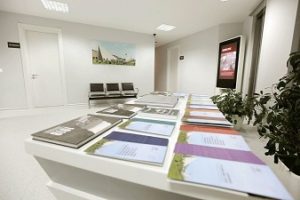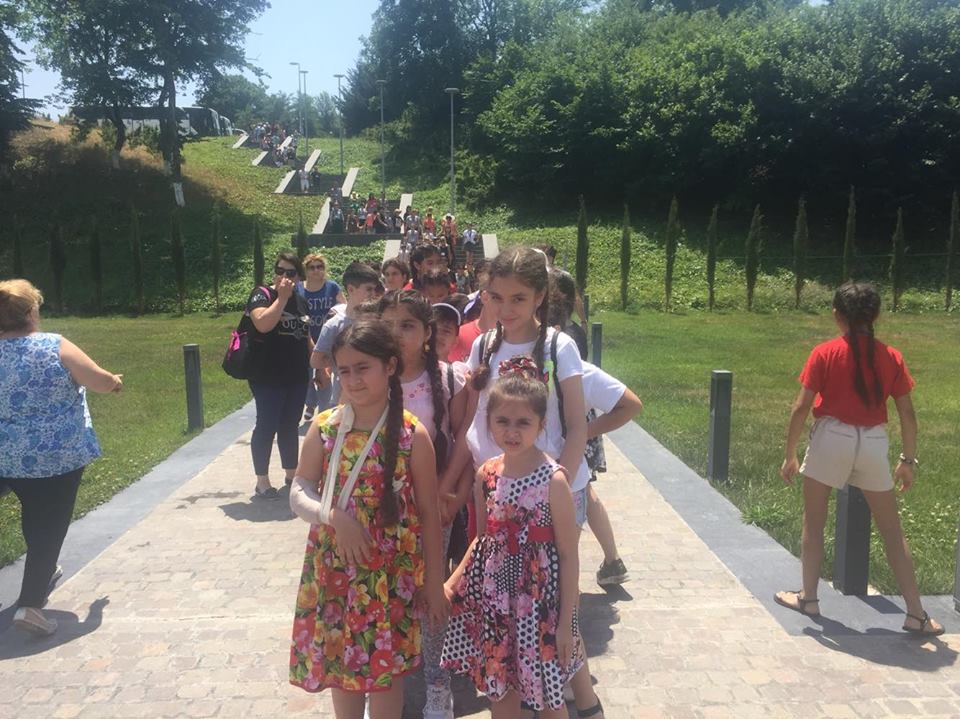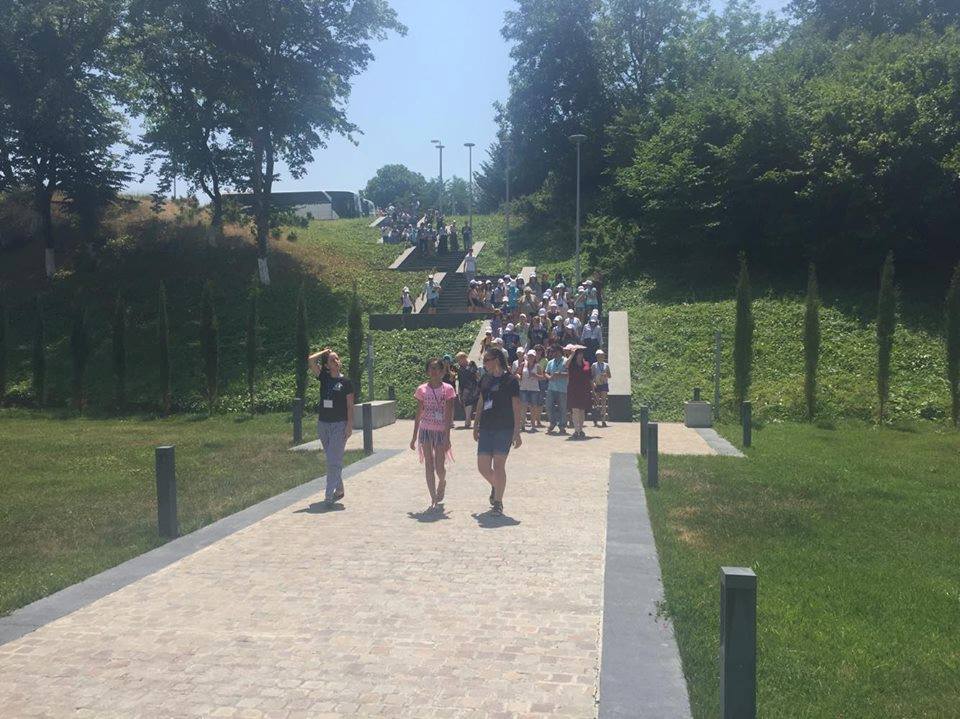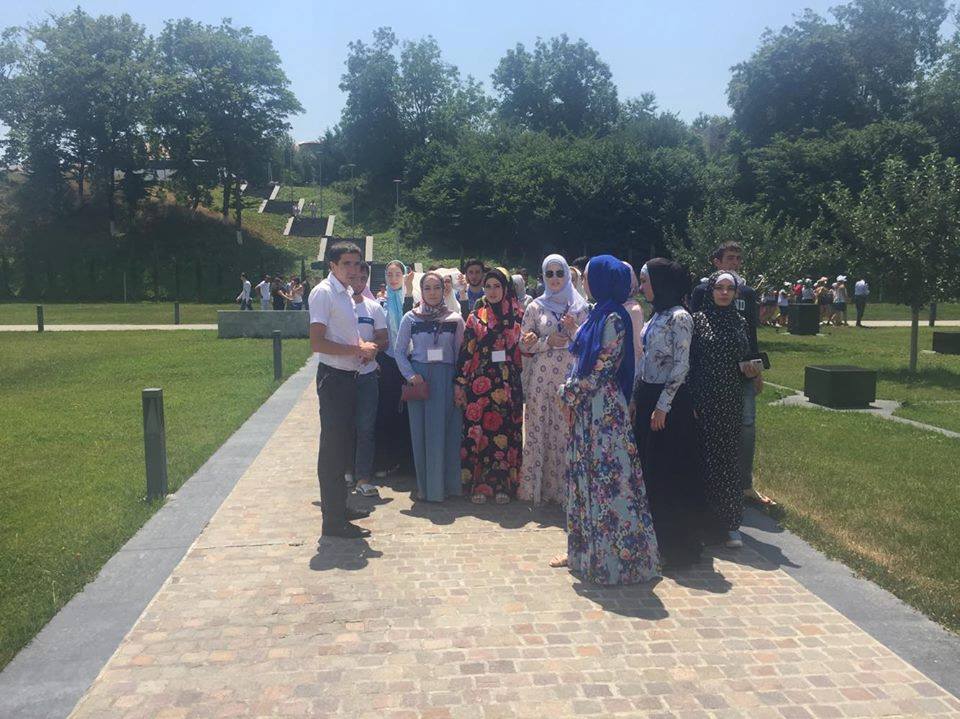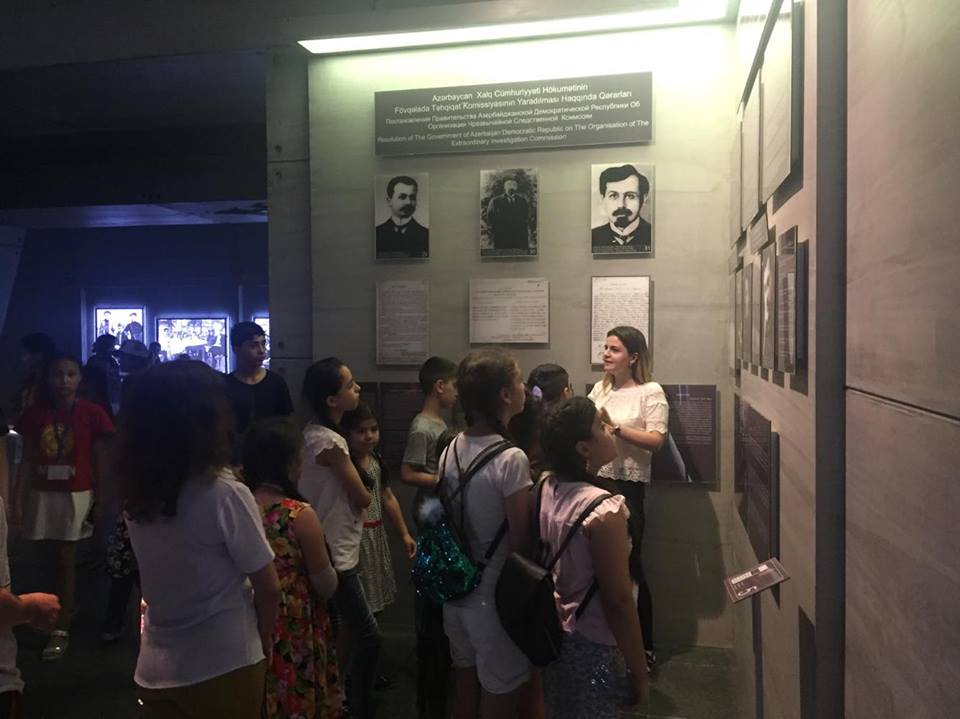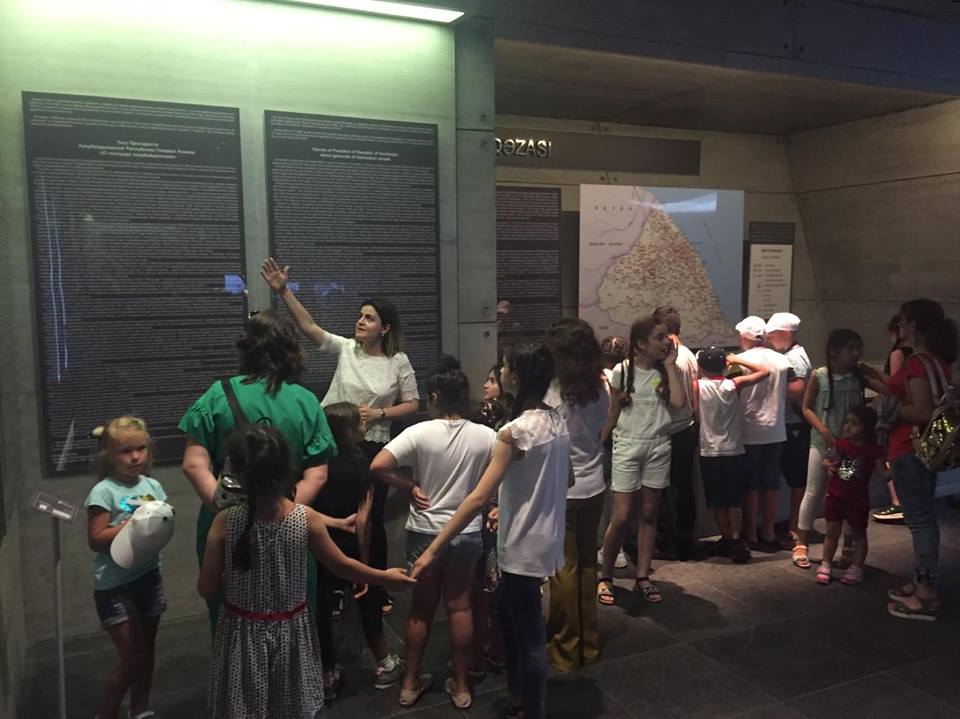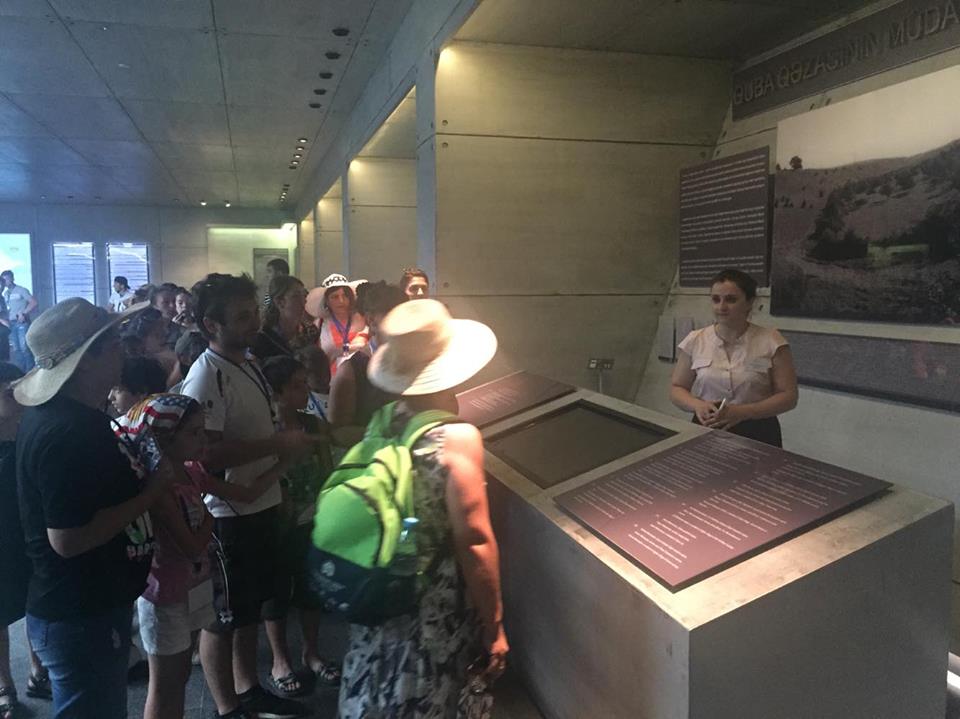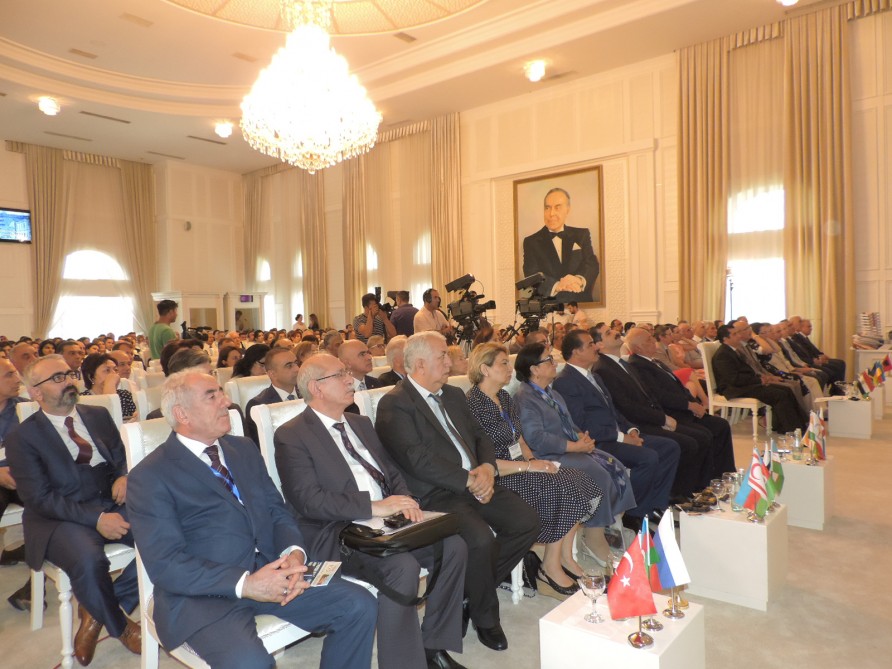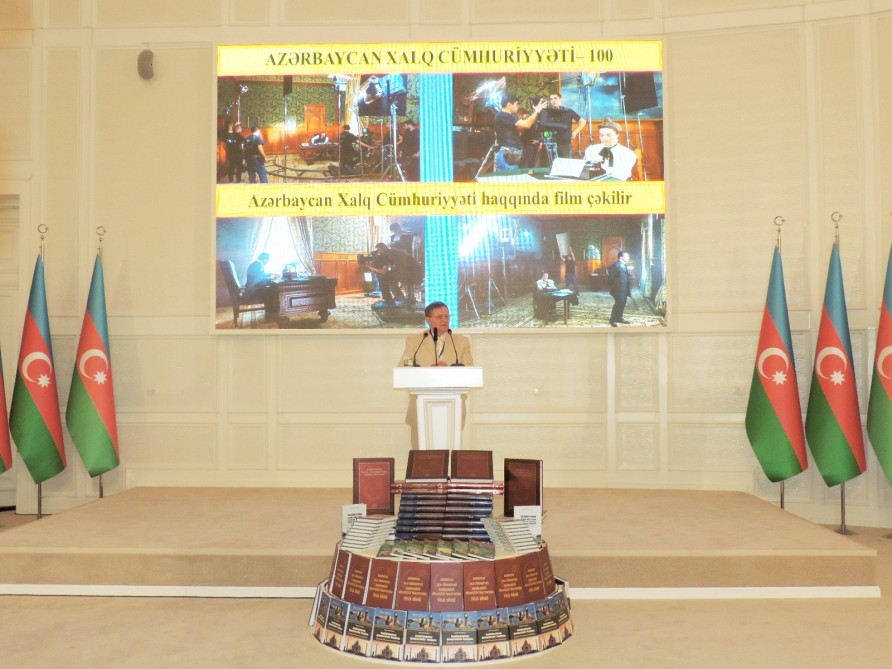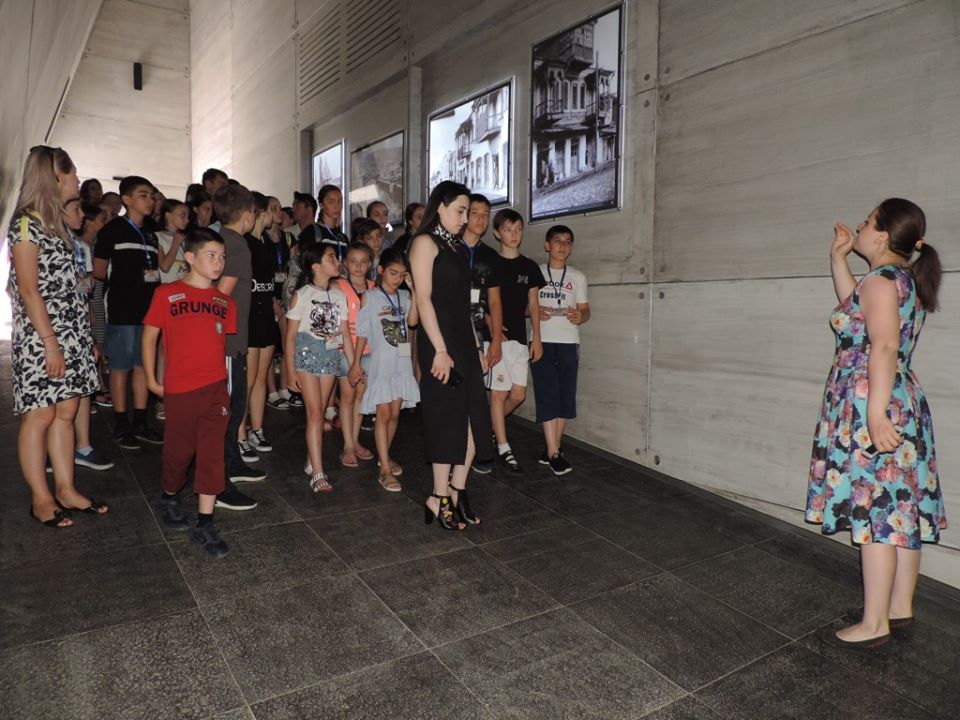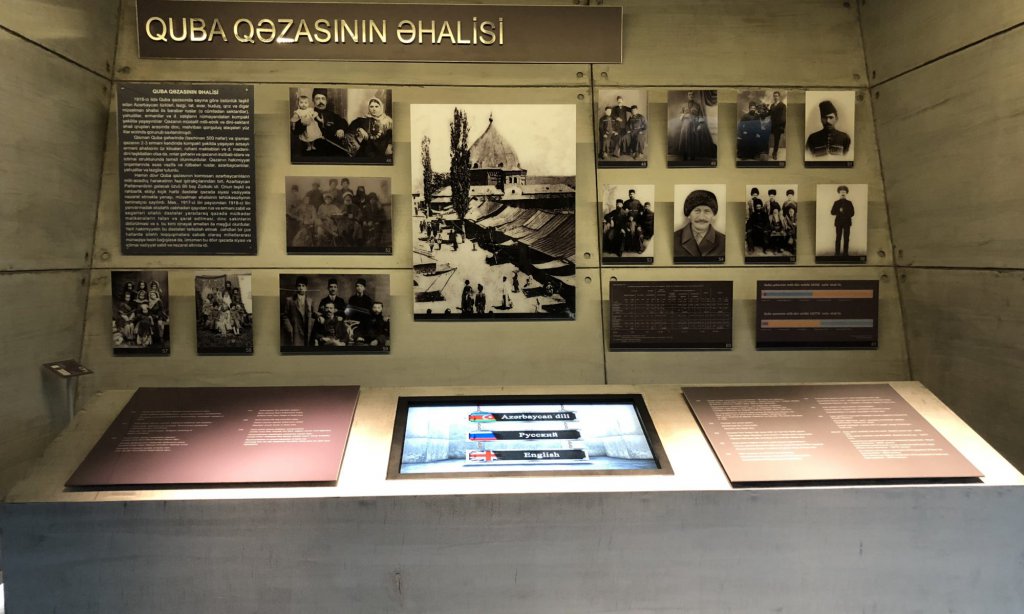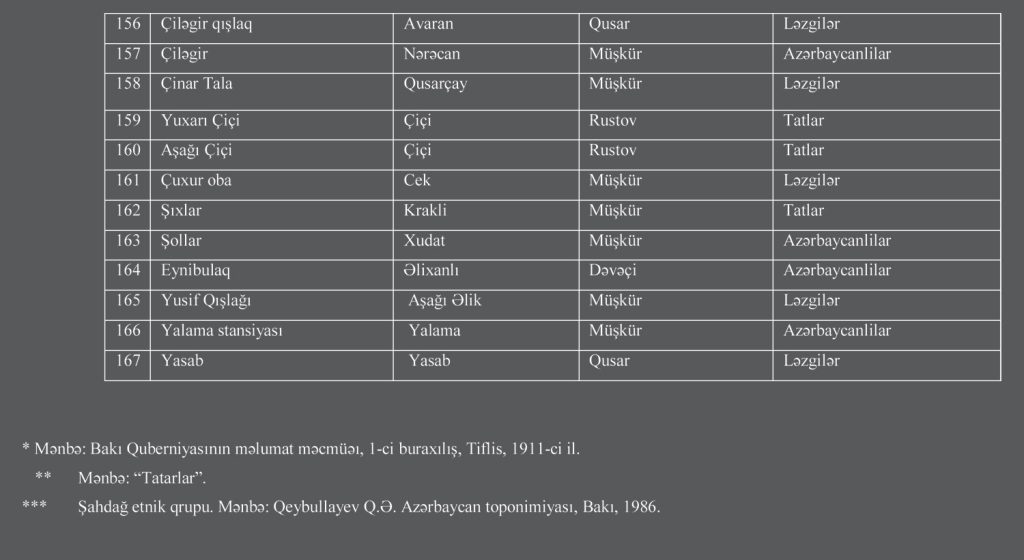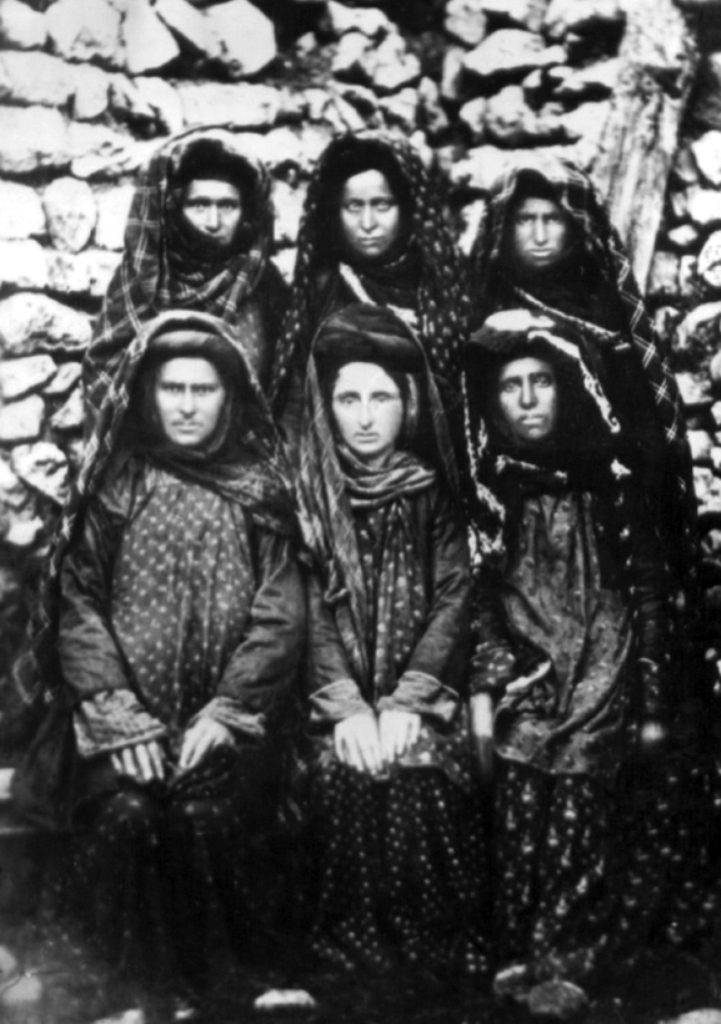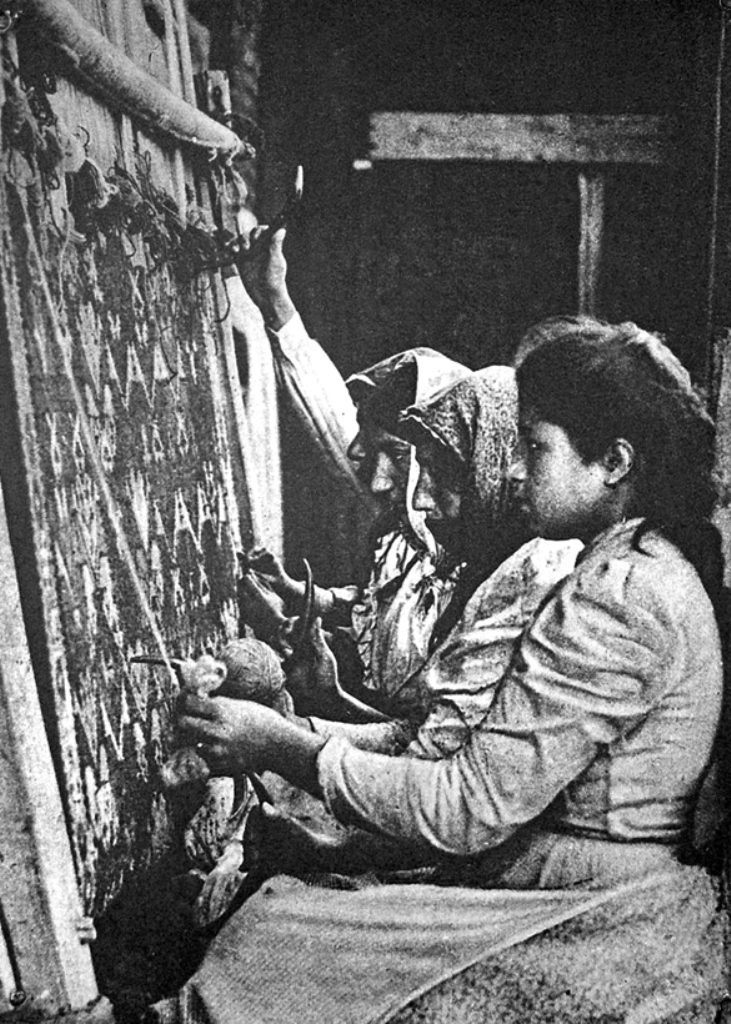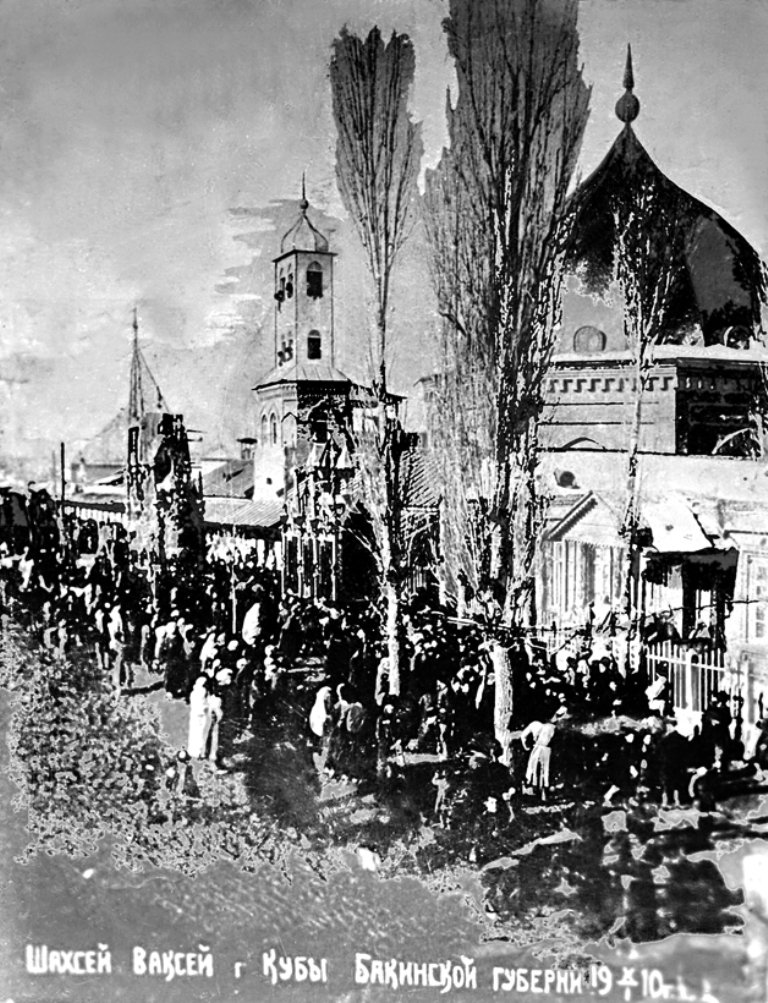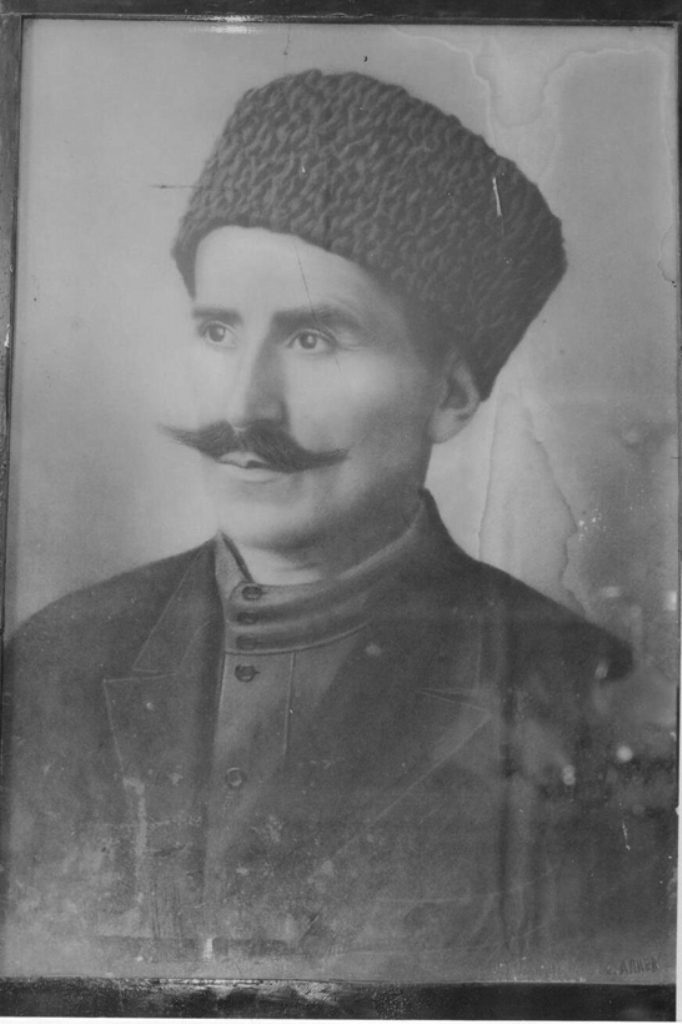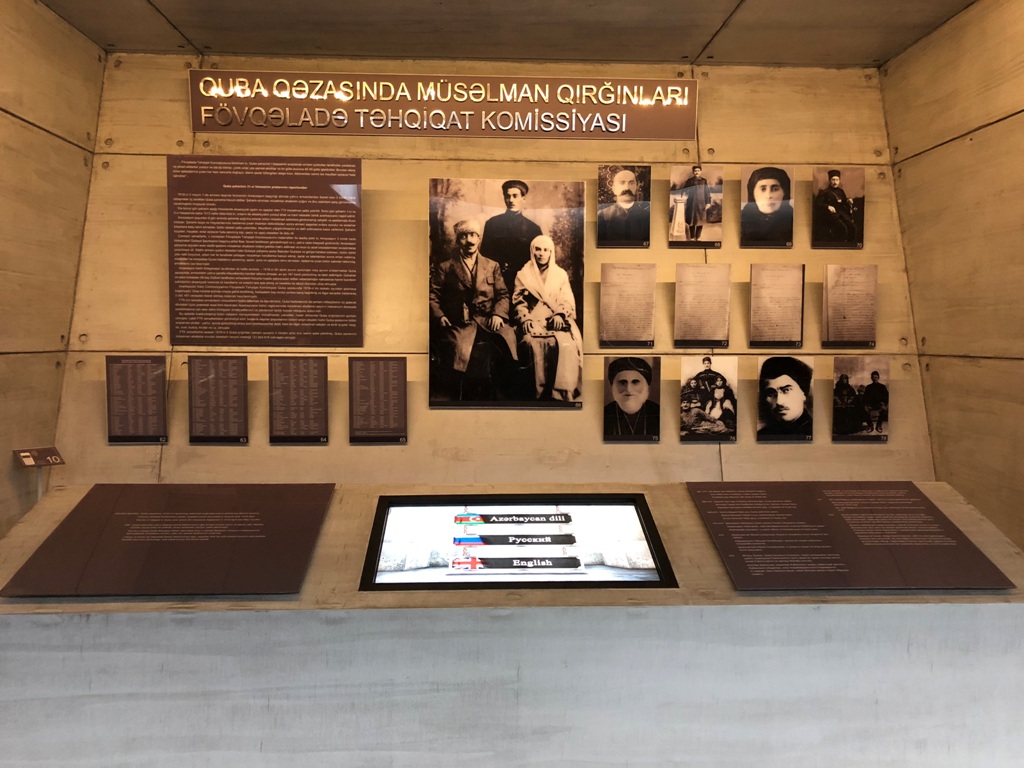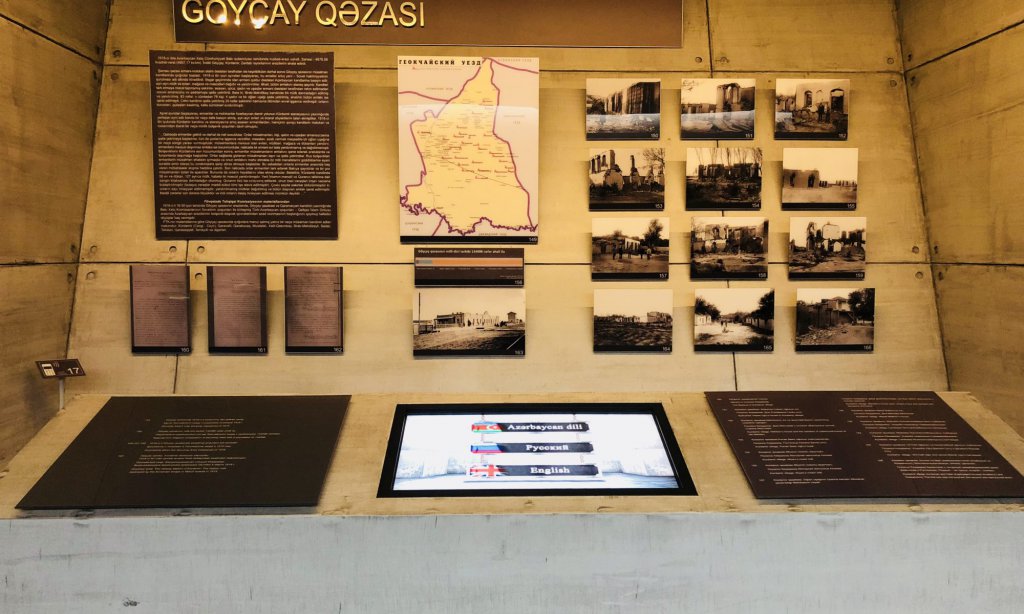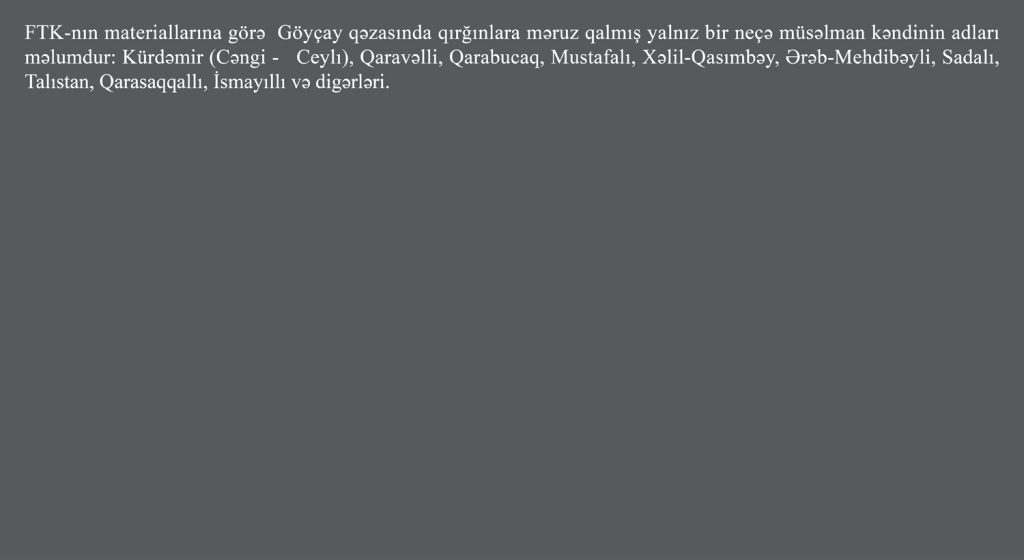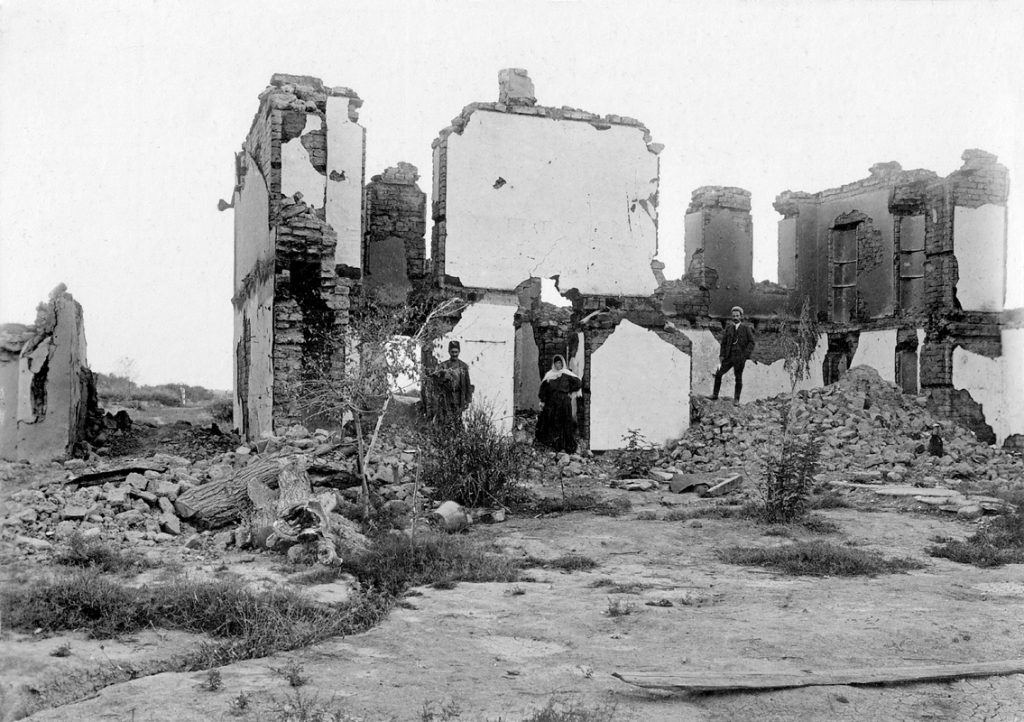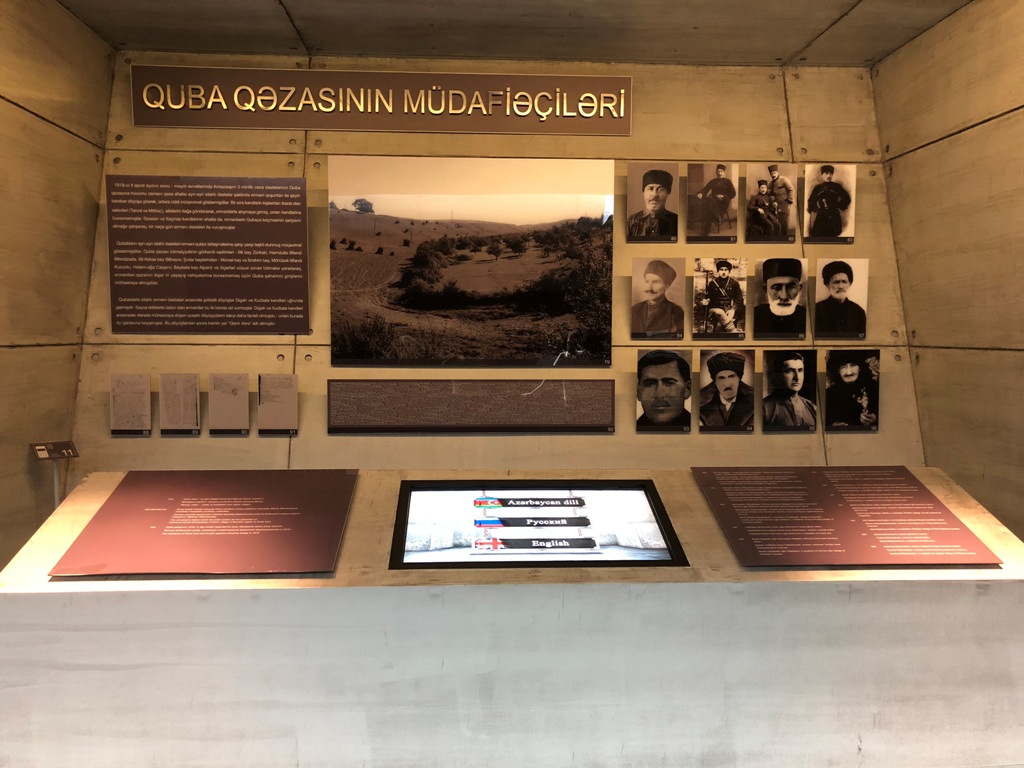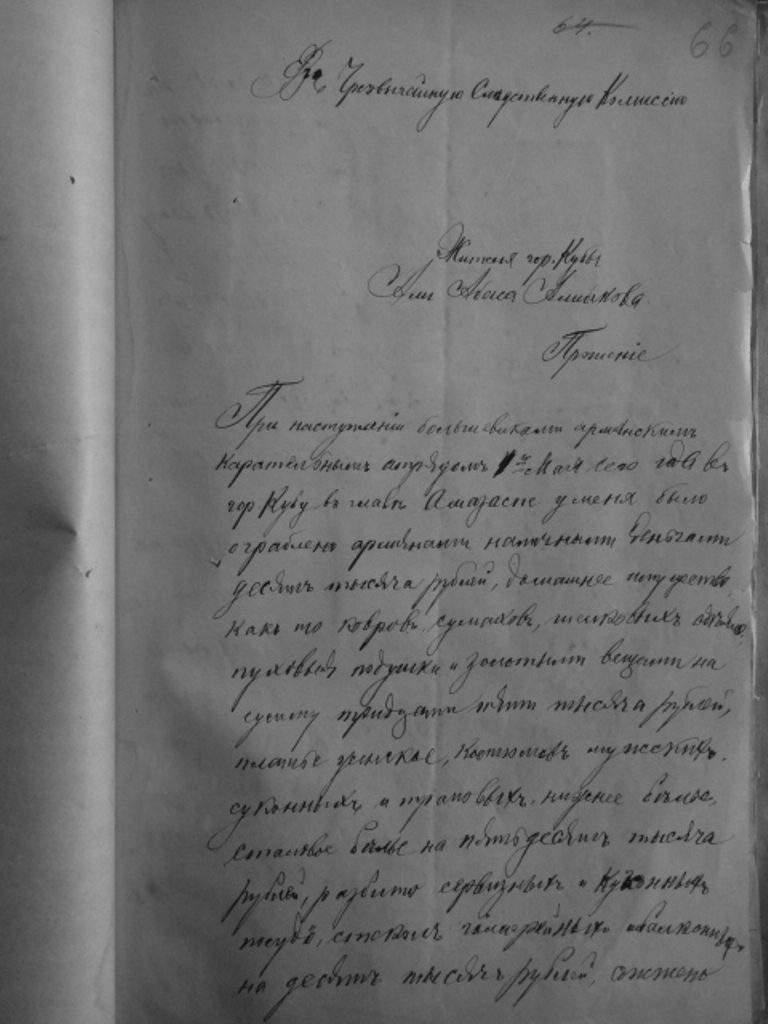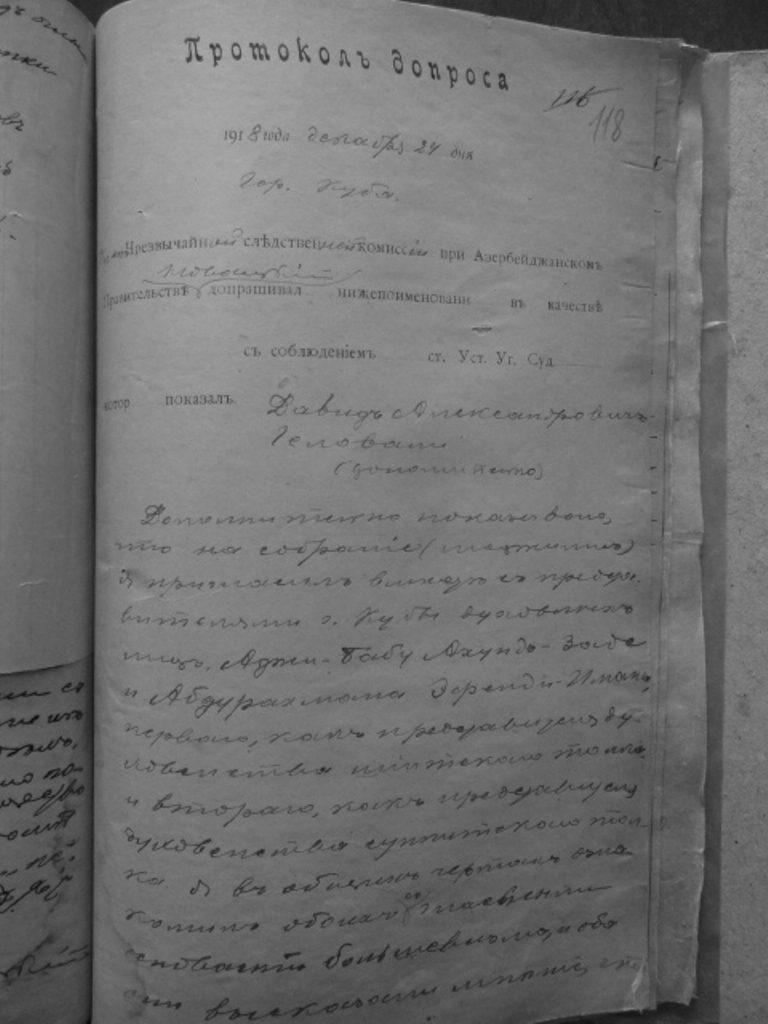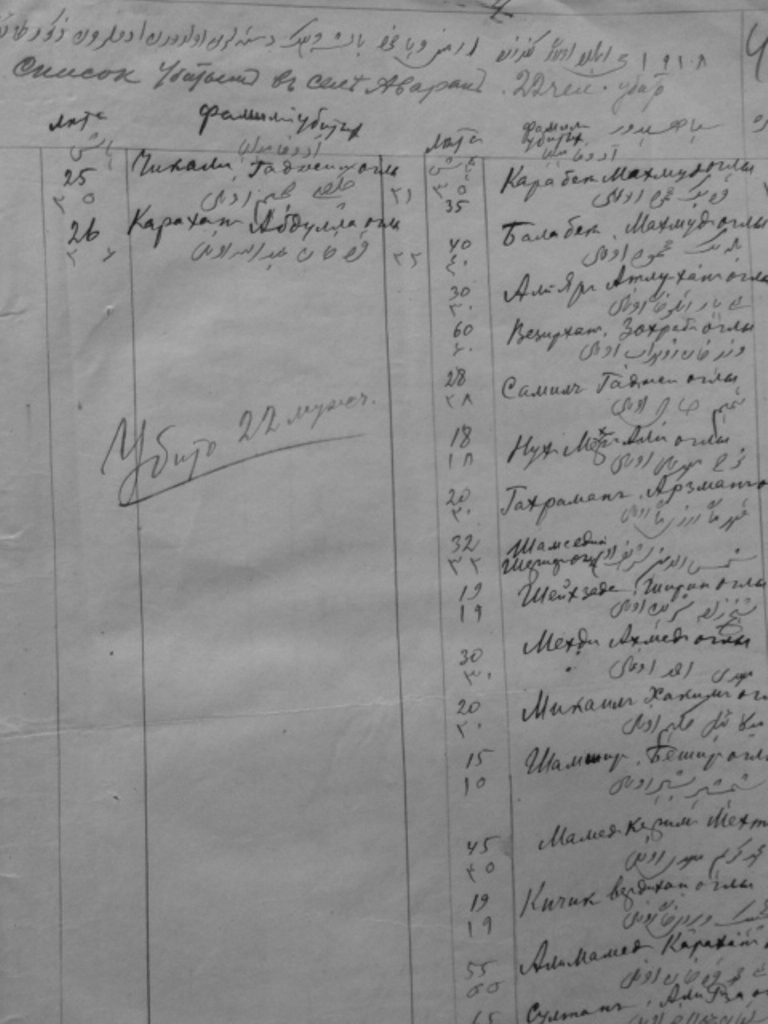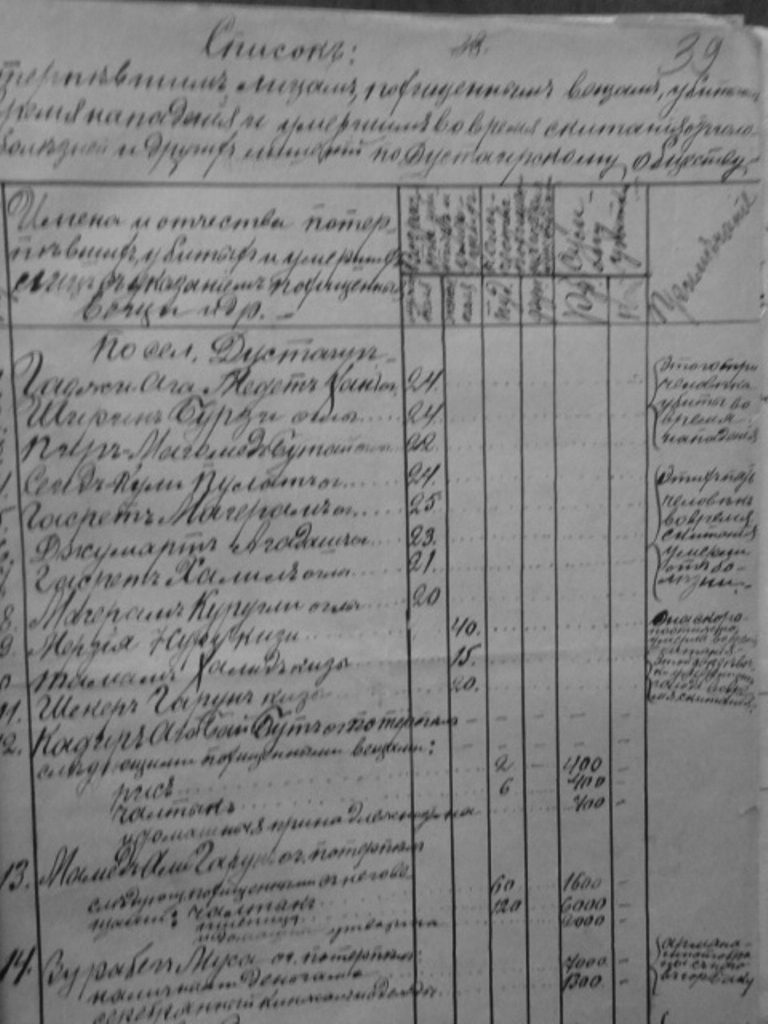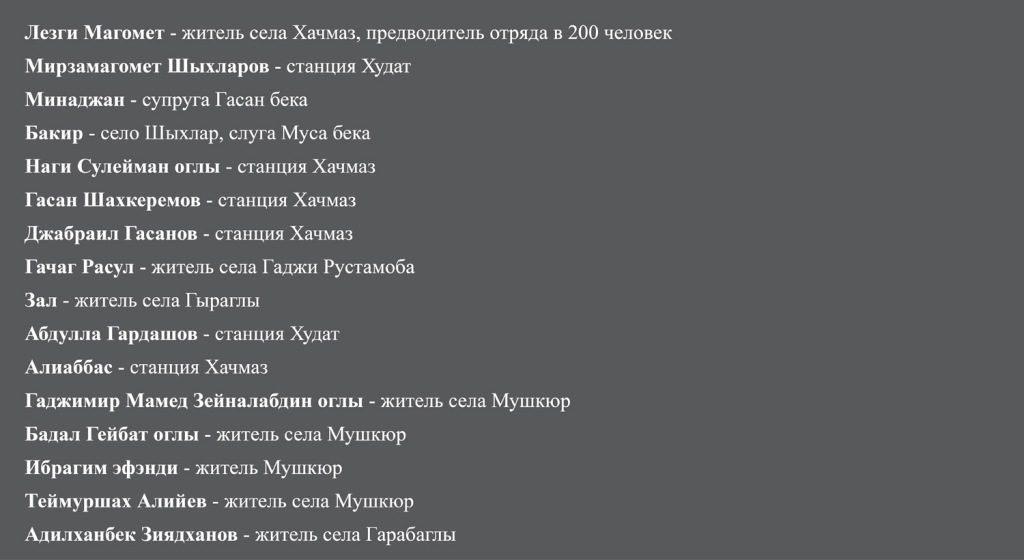The mass grave, discovered accidentally during the excavations for construction purposes in the town of Guba in 2007, was a clear evidence of the genocide of the Muslim population of Guba, committed by Armenian armed forces under Bolshevik name in May 1918. President of the Republic of Azerbaijan, Mr. Ilham Aliyev signed the disposal to create a “Genocide Memorial Complex” in Guba city on December 30, 2009 with a view to delivering these realities to the world community, preserving national memory of future generations of the Azerbaijani people and eternalizing the genocide victims’ memory. The Memorial Complex was constructed on the left bank of the Gudyalchay River in Guba city, in the former stadium area in 2012-2013. Official presentation of “Genocide Memorial Complex” was on September 18, 2013. The total area of the complex is 3.5 hectares and consists of 5 sections.  I Memorial (a place where a mass grave found)
I Memorial (a place where a mass grave found)
II Symbolic Cemetery
III Genocide Museum
IV Flag Square
V Information Center
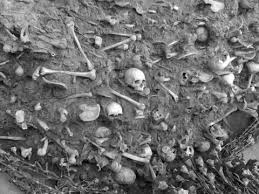 The mass grave was discovered on April 1, 2007, during construction works in the area. The staff of the Institute of Archaeology and Ethnography of the National Academy of Sciences of Azerbaijan carried out preliminary researches on the graveyard from 8 to 11 April, 2007 and the research has established that the burial has to do with the genocide committed by the Armenian armed groups against the local civilian population in 1918. The Scientific Council of the Institute of archeology and Ethnography of the National Academy of Sciences of Azerbaijan recommended to carry out more extensive research on the grave in order to clarify this issue. Research group of seven people of the Institute of Archeology and Ethnography of the National Academy of Sciences of Azerbaijan was engaged in research in the mass grave since July 2007, under the leadership of Gahraman Aghayev and completed in September 2008.
The mass grave was discovered on April 1, 2007, during construction works in the area. The staff of the Institute of Archaeology and Ethnography of the National Academy of Sciences of Azerbaijan carried out preliminary researches on the graveyard from 8 to 11 April, 2007 and the research has established that the burial has to do with the genocide committed by the Armenian armed groups against the local civilian population in 1918. The Scientific Council of the Institute of archeology and Ethnography of the National Academy of Sciences of Azerbaijan recommended to carry out more extensive research on the grave in order to clarify this issue. Research group of seven people of the Institute of Archeology and Ethnography of the National Academy of Sciences of Azerbaijan was engaged in research in the mass grave since July 2007, under the leadership of Gahraman Aghayev and completed in September 2008.
 II Symbolic Graveyard: Apple trees, symbolizing life in Guba since ancient times were planted in this part of the complex. 40 symbolic marble stones in 3 dimensions were placed in the apple garden in memory of women, young people, children and old people, who were the victims of the 1918 tragedy.
II Symbolic Graveyard: Apple trees, symbolizing life in Guba since ancient times were planted in this part of the complex. 40 symbolic marble stones in 3 dimensions were placed in the apple garden in memory of women, young people, children and old people, who were the victims of the 1918 tragedy.
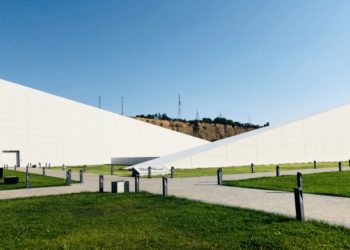 III Genocide Museum consists of 3 parts: 1. Grounding of sharp-end knives (entrance) 2. Memorial stone (main hall) 3. The emergence of sharp end knives (exit) The information on the changes occured in the lives of the population in social, cultural and other fields before , during after the genocide is reported in Socio-Historical Museum, which is unique in the world and new to Azerbaijan. . Architect Vahid Kasımoghlu did not use any decor and adornment as a sign of deep respect in memory of genocide victims, the scale, burden and pain of the tragedy and tried to opitomize mournful silence. Emerging of the museum view from under the ground suggests that truth can’t be concealed, while, the sharp ends of the monument exposes the stabbing pain.
III Genocide Museum consists of 3 parts: 1. Grounding of sharp-end knives (entrance) 2. Memorial stone (main hall) 3. The emergence of sharp end knives (exit) The information on the changes occured in the lives of the population in social, cultural and other fields before , during after the genocide is reported in Socio-Historical Museum, which is unique in the world and new to Azerbaijan. . Architect Vahid Kasımoghlu did not use any decor and adornment as a sign of deep respect in memory of genocide victims, the scale, burden and pain of the tragedy and tried to opitomize mournful silence. Emerging of the museum view from under the ground suggests that truth can’t be concealed, while, the sharp ends of the monument exposes the stabbing pain. 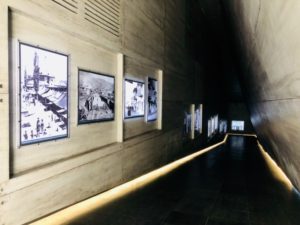 The entrance exposition of the museum is called ” Peaceful Guba”. The images of the residents of Guba town and the town view in the 20th century were depicted in this part. The photographs of the population of Guba town – civil servants, religious figures, schoolchildren, women and other urban and rural residents were taken during the work, at home, with the family and during the rest. The representatives of other nations and ethnic groups lived in Guba region densely along with the Azerbaijani Turks. Peaceful neighborly relations between different national-ethnic and religious populations of the town were preserved for centuries. This factor shows our people’s commitment to multiculturalism tradition. The entry part ends with the epigraph of “Azerbaijan” newspaper dated 8 December, 1918.
The entrance exposition of the museum is called ” Peaceful Guba”. The images of the residents of Guba town and the town view in the 20th century were depicted in this part. The photographs of the population of Guba town – civil servants, religious figures, schoolchildren, women and other urban and rural residents were taken during the work, at home, with the family and during the rest. The representatives of other nations and ethnic groups lived in Guba region densely along with the Azerbaijani Turks. Peaceful neighborly relations between different national-ethnic and religious populations of the town were preserved for centuries. This factor shows our people’s commitment to multiculturalism tradition. The entry part ends with the epigraph of “Azerbaijan” newspaper dated 8 December, 1918. 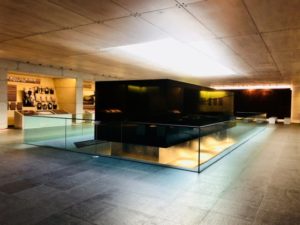 The black marble stone were erected in the center of the hall as a sign of respect for the memory of tragedy victims, because most people, subjected to massacres during the acts of genocide in various regions of Azerbaijan were burned, thrown into the sea and wells, and therefore their burial was impossible.
The black marble stone were erected in the center of the hall as a sign of respect for the memory of tragedy victims, because most people, subjected to massacres during the acts of genocide in various regions of Azerbaijan were burned, thrown into the sea and wells, and therefore their burial was impossible. 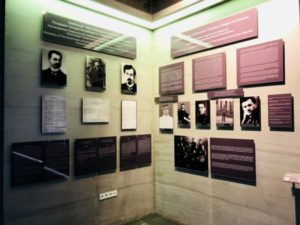 The photos and documents of members of the Extraordinary Investigation Commission (EIC) (F.Khoyski, M.Hajinski, H.Khasmammadov, A.Khasmammadov, I. Shahmaliyev, M. Tekinski, N.Mikhaylov, A.Khanbudagov) are displayed at the entry of the hall. The government of Democratic Republic of Azerbaijan (ADR) considered it necessary to express its attitude towards the bloody the Republic exposed. The government adopted a resolution on the establishment of Extraordinary Investigation Commission on 15 July, 1918 to investigate into the cases of violence committed against Muslim population and property by Armenian armed groups under the name of Bolshevik.The chairman of the EIC was known lawyer Alakbar bey Khasmammadov. Though the commission was set up of seven members, later the representatives of the investigation and prosecutor’s office and judicial authorities of Baku and Ganja cities were implicated to this work. The composition of the EIC was multinational and mainly included Polish, Russian, German, Lithuanian Tatars and Azerbaijani lawyers studying in Russia. 36 volumes of investigative materials were collected by the EIC during the activity period of 15 July, 1918 up to 1 November, 1919. Massacres committed in Baku, Shamakhi, Guba, Goychay, Javad, Nukha and Lankaran provinces, as well as in Ganja, Garabagh and Zangazur by Armenians were investigated. As a result of EIC activities, 128 reports and draft resolutions were worked up and criminal cases were instituted on their basis against 194 people, charged of various crimes.
The photos and documents of members of the Extraordinary Investigation Commission (EIC) (F.Khoyski, M.Hajinski, H.Khasmammadov, A.Khasmammadov, I. Shahmaliyev, M. Tekinski, N.Mikhaylov, A.Khanbudagov) are displayed at the entry of the hall. The government of Democratic Republic of Azerbaijan (ADR) considered it necessary to express its attitude towards the bloody the Republic exposed. The government adopted a resolution on the establishment of Extraordinary Investigation Commission on 15 July, 1918 to investigate into the cases of violence committed against Muslim population and property by Armenian armed groups under the name of Bolshevik.The chairman of the EIC was known lawyer Alakbar bey Khasmammadov. Though the commission was set up of seven members, later the representatives of the investigation and prosecutor’s office and judicial authorities of Baku and Ganja cities were implicated to this work. The composition of the EIC was multinational and mainly included Polish, Russian, German, Lithuanian Tatars and Azerbaijani lawyers studying in Russia. 36 volumes of investigative materials were collected by the EIC during the activity period of 15 July, 1918 up to 1 November, 1919. Massacres committed in Baku, Shamakhi, Guba, Goychay, Javad, Nukha and Lankaran provinces, as well as in Ganja, Garabagh and Zangazur by Armenians were investigated. As a result of EIC activities, 128 reports and draft resolutions were worked up and criminal cases were instituted on their basis against 194 people, charged of various crimes.  1918-1920 year map of Azerbaijan, which massacred regions in 1918 marked with special red content, and boards in 4 languages (Azerbaijani, Russian,Turkish and English), containing brief information about Azerbaijani history are placed in the following exposition.
1918-1920 year map of Azerbaijan, which massacred regions in 1918 marked with special red content, and boards in 4 languages (Azerbaijani, Russian,Turkish and English), containing brief information about Azerbaijani history are placed in the following exposition. 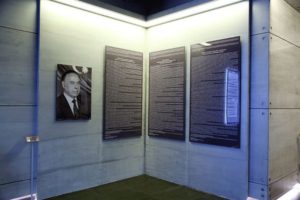 The photo of Great Leader, Haydar Aliyev, the founder and architect of modern Azerbaijani state, the Republic of Azerbaijan, which is the successor of the ADR, considered today the duty of political assessment of the genocide acts as its historical obligation, and logical continuation, because of incomplete realization nowadays, and Decree dated March 26, 1998 on “31 March genocide of Azerbaijanis” (in 3 languages: Azerbaijani, Russian, English) were displayed at the next exposition.
The photo of Great Leader, Haydar Aliyev, the founder and architect of modern Azerbaijani state, the Republic of Azerbaijan, which is the successor of the ADR, considered today the duty of political assessment of the genocide acts as its historical obligation, and logical continuation, because of incomplete realization nowadays, and Decree dated March 26, 1998 on “31 March genocide of Azerbaijanis” (in 3 languages: Azerbaijani, Russian, English) were displayed at the next exposition. 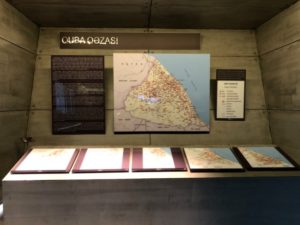 The whole museum gallery wall comprises the expositions of 4 sections, dedicated to the town of Guba. The state of Guba as an administrative territorial unit for the year of 1918 is described in the first section. Guba town (Guba, Gusar, Shabran, Khachmaz, Siyazan) existedMuntil the time of Tsarism Russia, ADR and the year of 1929 of the Azerbaijan SSR. The genocides committed in Guba town in 1918 were specially marked on the map in red. According to the first data, 122 villages were exposed to plunders and ruins in the province, whereas, more accurate investigations defined them to be 167. 38 settlements were ruined in Guba town and surrounding villages, 27- in Gusar, 65-in Khachmaz, 21- in Shabran, and 16- in Siyazan
The whole museum gallery wall comprises the expositions of 4 sections, dedicated to the town of Guba. The state of Guba as an administrative territorial unit for the year of 1918 is described in the first section. Guba town (Guba, Gusar, Shabran, Khachmaz, Siyazan) existedMuntil the time of Tsarism Russia, ADR and the year of 1929 of the Azerbaijan SSR. The genocides committed in Guba town in 1918 were specially marked on the map in red. According to the first data, 122 villages were exposed to plunders and ruins in the province, whereas, more accurate investigations defined them to be 167. 38 settlements were ruined in Guba town and surrounding villages, 27- in Gusar, 65-in Khachmaz, 21- in Shabran, and 16- in Siyazan 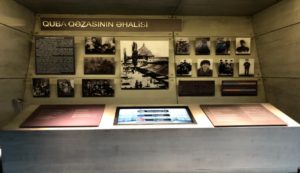 Detailed information on the living of Guba town population till 1918 is provided in the second section. According to 1916 data, 64,15% out of the 198, 204 population of Guba town were Azerbaijanis (Azeris) and Tats, 24,72% -Lezghins, Griz, Budugs, Jecks, Avars, etc., 7, 58%- Jews, 2, 71% were Russians, and 0.76% were Armenians.There are photos of different nations and ethnic groups in this showcase.
Detailed information on the living of Guba town population till 1918 is provided in the second section. According to 1916 data, 64,15% out of the 198, 204 population of Guba town were Azerbaijanis (Azeris) and Tats, 24,72% -Lezghins, Griz, Budugs, Jecks, Avars, etc., 7, 58%- Jews, 2, 71% were Russians, and 0.76% were Armenians.There are photos of different nations and ethnic groups in this showcase. 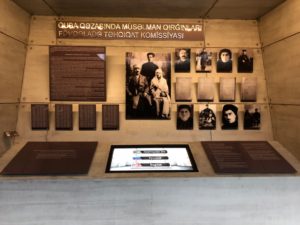 A brief description of the EIC facts on the destruction, violence and genocide conducted in Guba town, as well as the documents and photographs of witnesses of the acts and interrogation protocols were demonstrated in the third section.
A brief description of the EIC facts on the destruction, violence and genocide conducted in Guba town, as well as the documents and photographs of witnesses of the acts and interrogation protocols were demonstrated in the third section.  The information on Guba town defenders exists on the fourth section. 3,000 Armenian armed gangs of Hamazasp committed brutal murders and pillages in Guba town from late April till mid-May, 1918 within two weeks by the order of Baku Soviet head, S. Shaumian. Main purpose of the Dashnak Hamazasp, who had a special hatred towards Turks, was to fulfil penal measures and to reduce the number of the Muslim population purposefully. The Armenian gangs of Hamazasp murdered without mercy, even with unprecedented cruelty, Muslim population, including children, women, old people and treated corpses ruthlessly and even banned to take them from the streets and squares, and to bury them. A document on Azerbaijani people’s being a tolerant nation even under such conditions as compared with Armenians, was presented. This document was issued for the protection of ninety Armenians’ life safety by personal signature and seal of Hamdulla Efendi Efendizade in Kilvar village of Devechi (Shabran). The photographs of defenders of Guba town were presented at the exposition (A.Zizikski, H. Efendizade, S. Efendizade, M. Ibrahimov and others). There was informed about the struggle of defense forces of Guba town against the Dashnaks-Armenians and presented the view of the area called “Bloody Valley”, located between the villages of Digah and Khujbala, where fierce battles took place.
The information on Guba town defenders exists on the fourth section. 3,000 Armenian armed gangs of Hamazasp committed brutal murders and pillages in Guba town from late April till mid-May, 1918 within two weeks by the order of Baku Soviet head, S. Shaumian. Main purpose of the Dashnak Hamazasp, who had a special hatred towards Turks, was to fulfil penal measures and to reduce the number of the Muslim population purposefully. The Armenian gangs of Hamazasp murdered without mercy, even with unprecedented cruelty, Muslim population, including children, women, old people and treated corpses ruthlessly and even banned to take them from the streets and squares, and to bury them. A document on Azerbaijani people’s being a tolerant nation even under such conditions as compared with Armenians, was presented. This document was issued for the protection of ninety Armenians’ life safety by personal signature and seal of Hamdulla Efendi Efendizade in Kilvar village of Devechi (Shabran). The photographs of defenders of Guba town were presented at the exposition (A.Zizikski, H. Efendizade, S. Efendizade, M. Ibrahimov and others). There was informed about the struggle of defense forces of Guba town against the Dashnaks-Armenians and presented the view of the area called “Bloody Valley”, located between the villages of Digah and Khujbala, where fierce battles took place. 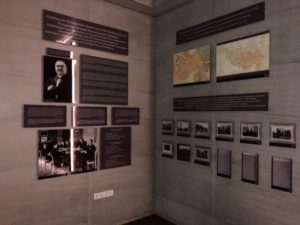 The photographs of the delegation participated at the Paris Peace Conference of 1919 (A. Topchubashov-chairman, A. Atamalibeyov, Y. Mehdiyev, J. Hajibeyli, A.Sheikhulislamov, M, Maharramov), as well as the published historical maps of Caucasus showing borders of ADR (in French and Ottoman Turkish) were presented at the next exposition. Main purpose of the delegation was to introduce Azerbaijan as an independent state and to bring the crimes committed by the Armenians-Dashnaks against the Azerbaijani people in 1918, to the world community. For this purpose, a part of the materials of the EIC were sent to Paris through Foreign Ministry of Azerbaijan with a delegation. These materials consisted of 6 volumes of documents and 102 photos reflecting 1918 genocides committed in Baku, Shamakhi, Guba, Goychay and Javad provinces. The Azerbaijani delegation fulfilled its commitment, it was undertaken. The copies of the documents were submitted to the heads of major states and different international organizations. All the materials sent from Baku to Paris were found in personal archive of Topchubashov in France by PhD of History, Prof. Solmaz Rustamova (Tohidi) in 2011 and submitted back to the homeland after 94 years. The copies of the documents and photos are presented in their original at the museum exposition. A documentary dealt with the acts of genocide is continuously shown in the hall.
The photographs of the delegation participated at the Paris Peace Conference of 1919 (A. Topchubashov-chairman, A. Atamalibeyov, Y. Mehdiyev, J. Hajibeyli, A.Sheikhulislamov, M, Maharramov), as well as the published historical maps of Caucasus showing borders of ADR (in French and Ottoman Turkish) were presented at the next exposition. Main purpose of the delegation was to introduce Azerbaijan as an independent state and to bring the crimes committed by the Armenians-Dashnaks against the Azerbaijani people in 1918, to the world community. For this purpose, a part of the materials of the EIC were sent to Paris through Foreign Ministry of Azerbaijan with a delegation. These materials consisted of 6 volumes of documents and 102 photos reflecting 1918 genocides committed in Baku, Shamakhi, Guba, Goychay and Javad provinces. The Azerbaijani delegation fulfilled its commitment, it was undertaken. The copies of the documents were submitted to the heads of major states and different international organizations. All the materials sent from Baku to Paris were found in personal archive of Topchubashov in France by PhD of History, Prof. Solmaz Rustamova (Tohidi) in 2011 and submitted back to the homeland after 94 years. The copies of the documents and photos are presented in their original at the museum exposition. A documentary dealt with the acts of genocide is continuously shown in the hall.  Modern human faces are depicted in the applied art tableau at the next exposition. These figures embody young and old generations. Views of the faces are different. There is felt astonishment, amazement and fear on younger faces, while, there are as much as grief, sadness and bitterness on old faces.
Modern human faces are depicted in the applied art tableau at the next exposition. These figures embody young and old generations. Views of the faces are different. There is felt astonishment, amazement and fear on younger faces, while, there are as much as grief, sadness and bitterness on old faces.  The following exposition presents the names of the leaders and executors of the 1918 slaughters (Shaumian, Hamazasp, Korganov, Andranin, Lalayan, Mikoyan, etc.) and the essence of their genocide policy.
The following exposition presents the names of the leaders and executors of the 1918 slaughters (Shaumian, Hamazasp, Korganov, Andranin, Lalayan, Mikoyan, etc.) and the essence of their genocide policy. 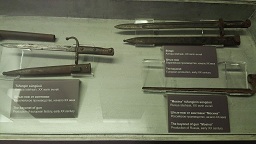 The Armenians, who considered Azerbaijan a potential territory for the “Greater Armenia” State and at the same time aiming at minimizing the Muslim population through genocides in the region, used all means to achieve their goal. The head of the Baku Soviet, Shaumian trying to fulfill this plan, collaborated closely with the Armenian forces of the entire Caucasus, including the members of “Dashnaksytun” Party. He took harsher penal measures in different parts of Azerbaijan abusing the competences, committed to him. Thus, tragic events of 1918 were carried out by the Bolshevik-Dashnak tandem. Mass slaughters of Muslim population were committed by the troops of 70% Armenian soldiers, and led by Armenian officers since March 1918. The fact of display of the names and identities of the leaders of the Armenian forces and executors, committed genocide in Azerbaijan denies the fiction of Armenians spread in Armenians bodies of that time or even present day, about this tragedy’s being allegedly committed by the “Armenian ordinary people”.There are also shown in the showcase the sidearms, firearms and torture devices used by Armenian troops during the genocide acts.
The Armenians, who considered Azerbaijan a potential territory for the “Greater Armenia” State and at the same time aiming at minimizing the Muslim population through genocides in the region, used all means to achieve their goal. The head of the Baku Soviet, Shaumian trying to fulfill this plan, collaborated closely with the Armenian forces of the entire Caucasus, including the members of “Dashnaksytun” Party. He took harsher penal measures in different parts of Azerbaijan abusing the competences, committed to him. Thus, tragic events of 1918 were carried out by the Bolshevik-Dashnak tandem. Mass slaughters of Muslim population were committed by the troops of 70% Armenian soldiers, and led by Armenian officers since March 1918. The fact of display of the names and identities of the leaders of the Armenian forces and executors, committed genocide in Azerbaijan denies the fiction of Armenians spread in Armenians bodies of that time or even present day, about this tragedy’s being allegedly committed by the “Armenian ordinary people”.There are also shown in the showcase the sidearms, firearms and torture devices used by Armenian troops during the genocide acts.  Theme of Baku province districts follows the exposition on Javad ditrict. Javad province covers the area of present Salyan, Saatli, Imishli, Sabirabad and Jalilabad regions.The province and the composition of the population are reported in the textual part of Javad exposition. Armenians committed genocide act against Muslim population till the mid March-June, 1918 in the province. The civil population of the province was subjected to rather much persecution after Salyan’s fall under Bolsheviks’ control in April of that year. This situation continued until our lands were liberated by Azerbaijani-Turkish troops. It was impossible to obtain amount of the damage to the villages and the exact list of the killed people, since a part of the Muslim villages was still under Armenian control during the EIC activity. However, it was not difficult to imagine the scale of the atrocities and vandalism committed by Armenians against the local Muslim population. From this point of view,it would be enough to look at the questionnaire and the forensic examination protocol of the 18-year-old resident of Khojali village of Javad province, Surayya Mashadi Dadash gizi at the exposition. The assassinations were accompanied by special brutality: They run through the people with bayonets, hacked with daggers, cut their heads and burned them.
Theme of Baku province districts follows the exposition on Javad ditrict. Javad province covers the area of present Salyan, Saatli, Imishli, Sabirabad and Jalilabad regions.The province and the composition of the population are reported in the textual part of Javad exposition. Armenians committed genocide act against Muslim population till the mid March-June, 1918 in the province. The civil population of the province was subjected to rather much persecution after Salyan’s fall under Bolsheviks’ control in April of that year. This situation continued until our lands were liberated by Azerbaijani-Turkish troops. It was impossible to obtain amount of the damage to the villages and the exact list of the killed people, since a part of the Muslim villages was still under Armenian control during the EIC activity. However, it was not difficult to imagine the scale of the atrocities and vandalism committed by Armenians against the local Muslim population. From this point of view,it would be enough to look at the questionnaire and the forensic examination protocol of the 18-year-old resident of Khojali village of Javad province, Surayya Mashadi Dadash gizi at the exposition. The assassinations were accompanied by special brutality: They run through the people with bayonets, hacked with daggers, cut their heads and burned them.  Goychay province was an administrative-territorial unit within Baku province of ADR in 1918 and covered the territory of present Goychay, Kurdamir and Zardab regions. The exposition provides information on nationalreligious composition of the population (Muslim, Armenian, Russian, Jewish) in the administrative part at the exposition. The passing of several railway stations through Goychay area facilitated the attack of the Armenian armed forces left during the World War I and went back to this region. Armenians became even more aggressive with the purpose to build Bolshevik government since June, 1918. So, 84 premises were set to fire in Arab-Mehdibey Village, property was plundered and 83 people were slain. 20 residents of the Jahri village were subjected to unbearable tortures and then murdered. Their noses and ears are cut off and the skull bones are broken. The similar violence was also conducted in Kurdamir Village. EIC papers of research, implemented in the region and the photographs of burnt mosque, personal property, houses and corpses in the village are presented on the board. The liberation of our lands from Bolshevik Dashnak forces took start with conclusive fights between the BPCS army and the Caucasus Islamic Army only in the directions of Goychay settlement and Garamaryam Village on 16-30th June, 1918.
Goychay province was an administrative-territorial unit within Baku province of ADR in 1918 and covered the territory of present Goychay, Kurdamir and Zardab regions. The exposition provides information on nationalreligious composition of the population (Muslim, Armenian, Russian, Jewish) in the administrative part at the exposition. The passing of several railway stations through Goychay area facilitated the attack of the Armenian armed forces left during the World War I and went back to this region. Armenians became even more aggressive with the purpose to build Bolshevik government since June, 1918. So, 84 premises were set to fire in Arab-Mehdibey Village, property was plundered and 83 people were slain. 20 residents of the Jahri village were subjected to unbearable tortures and then murdered. Their noses and ears are cut off and the skull bones are broken. The similar violence was also conducted in Kurdamir Village. EIC papers of research, implemented in the region and the photographs of burnt mosque, personal property, houses and corpses in the village are presented on the board. The liberation of our lands from Bolshevik Dashnak forces took start with conclusive fights between the BPCS army and the Caucasus Islamic Army only in the directions of Goychay settlement and Garamaryam Village on 16-30th June, 1918.  Shamakhi province was an administrative-territorial unit and covered the areas of present Shamakhi, Agsu, Ismayilli, Gobustan,Hajigabul regions. The composition of Shamakhi province population was different for religious and national background like other provinces. Despite the majority of the province’s Muslim population, it was exposed to unexpected storming by ArmeniansBolsheviks and faced with unprecedented atrocities. The genocides in Shamakhi were launched at the same time with Baku events. Shamakhi town was hit twice in March-April, while 110 villages of the province were exposed to plunders for several times. Genocides committed by the Bolshevik-Dashnak bands in Shamakhi town lasted for several days.”Piran-Shirvan” residential estates, populated with rich Moslems were completely set on fire. The Armenians re-attacked the town on 10 April under the guidance of S. Lalayev and T. Amirov after the March massacres. Religious centers of Shamakhi, as well as Juma Mosque with 8th centuries-old history, were burnt and ruined. Generally, 106 villages of Shamakhi province were devastated by Armenians during this period and 10341 people were killed. These facts were demonstrated as photographs at the exposition.
Shamakhi province was an administrative-territorial unit and covered the areas of present Shamakhi, Agsu, Ismayilli, Gobustan,Hajigabul regions. The composition of Shamakhi province population was different for religious and national background like other provinces. Despite the majority of the province’s Muslim population, it was exposed to unexpected storming by ArmeniansBolsheviks and faced with unprecedented atrocities. The genocides in Shamakhi were launched at the same time with Baku events. Shamakhi town was hit twice in March-April, while 110 villages of the province were exposed to plunders for several times. Genocides committed by the Bolshevik-Dashnak bands in Shamakhi town lasted for several days.”Piran-Shirvan” residential estates, populated with rich Moslems were completely set on fire. The Armenians re-attacked the town on 10 April under the guidance of S. Lalayev and T. Amirov after the March massacres. Religious centers of Shamakhi, as well as Juma Mosque with 8th centuries-old history, were burnt and ruined. Generally, 106 villages of Shamakhi province were devastated by Armenians during this period and 10341 people were killed. These facts were demonstrated as photographs at the exposition. 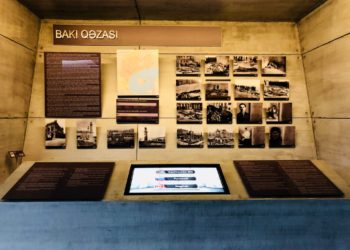 The theme of Baku province comes to an end with Baku exposition. The factors causing these events in Baku City, where in 1918 genocide launched, and March genocide were reported there. Baku province with 442.097 population was distinctive for its multinational content. Although the population of Baku City had increased due to the migrants arrived because of the two-centuries-old transfer policy and the development of oil industry from the second half of the 19th century, the majority were Muslims, mostly Azerbaijanis. The exposition included a map of Baku province, a diagram of the nationalreligious content of the population, the photographs of victims of genocide, and interrogation protocols. The Bolshevik-Dashnak forces intensified their efforts to strike the national-liberation movement of the Azerbaijani people, to destroy the social basis of “Musavat” Party and minimize the number of Muslim population. Sabotage on disarmament of the main crew of “Evelina” streamship consisted of Azerbaijanis on March 26, 1918 was an excuse for conducting Moslem’s massacres by ten thousand Bolshevik Armenian army. Twelve thousand peaceful Moslem civils of the city were bloodshed for three days (March 30 – April 2). Existence of women, grown-ups and children among the murdered denies the claims on allegedly occurence of “civil war” inside the city and proves the massacres were committed massively against the Muslim population. All strata of Azerbaijani population were victims of violence, injustice and pillages during massacres led by slaughters of the Armenian “Dashnakstyun”, the Armenian National Council and the Bolsheviks. Quarters of Baku “Karpijkhana”, “Mammadli” and others, “Tazapir”, “Shah”, “Shamakhi”, “Haji Ajdar bey”, “Bibiheybat” mosques, as well as editorial offices of “Kaspi”, “Open Word” newspapers, the building of “Isgandariyya” and “Islamiyya” hotels were destroyed and burnt. The photos of a number of places mentioned in the exposition are provided. The genocides conducted in Baku in March-September, 1918 were also committed in Baku villages (Mahammadli, Ahmadli, Balakhani, Zarat, Sabunchu, Khirdalan, etc.) Total damage caused to Baku province amounted to about 400,000,000 rubles
The theme of Baku province comes to an end with Baku exposition. The factors causing these events in Baku City, where in 1918 genocide launched, and March genocide were reported there. Baku province with 442.097 population was distinctive for its multinational content. Although the population of Baku City had increased due to the migrants arrived because of the two-centuries-old transfer policy and the development of oil industry from the second half of the 19th century, the majority were Muslims, mostly Azerbaijanis. The exposition included a map of Baku province, a diagram of the nationalreligious content of the population, the photographs of victims of genocide, and interrogation protocols. The Bolshevik-Dashnak forces intensified their efforts to strike the national-liberation movement of the Azerbaijani people, to destroy the social basis of “Musavat” Party and minimize the number of Muslim population. Sabotage on disarmament of the main crew of “Evelina” streamship consisted of Azerbaijanis on March 26, 1918 was an excuse for conducting Moslem’s massacres by ten thousand Bolshevik Armenian army. Twelve thousand peaceful Moslem civils of the city were bloodshed for three days (March 30 – April 2). Existence of women, grown-ups and children among the murdered denies the claims on allegedly occurence of “civil war” inside the city and proves the massacres were committed massively against the Muslim population. All strata of Azerbaijani population were victims of violence, injustice and pillages during massacres led by slaughters of the Armenian “Dashnakstyun”, the Armenian National Council and the Bolsheviks. Quarters of Baku “Karpijkhana”, “Mammadli” and others, “Tazapir”, “Shah”, “Shamakhi”, “Haji Ajdar bey”, “Bibiheybat” mosques, as well as editorial offices of “Kaspi”, “Open Word” newspapers, the building of “Isgandariyya” and “Islamiyya” hotels were destroyed and burnt. The photos of a number of places mentioned in the exposition are provided. The genocides conducted in Baku in March-September, 1918 were also committed in Baku villages (Mahammadli, Ahmadli, Balakhani, Zarat, Sabunchu, Khirdalan, etc.) Total damage caused to Baku province amounted to about 400,000,000 rubles  Expositions showing the attitude of the states officials, prominent persons and media towards the genocide acts committed by Armenian troops in Azerbaijan in 1918 were demonstrated at the museum exit. The views of the graveyard discovered during 2007 constructions are on the 1st showcase (photo).
Expositions showing the attitude of the states officials, prominent persons and media towards the genocide acts committed by Armenian troops in Azerbaijan in 1918 were demonstrated at the museum exit. The views of the graveyard discovered during 2007 constructions are on the 1st showcase (photo). 
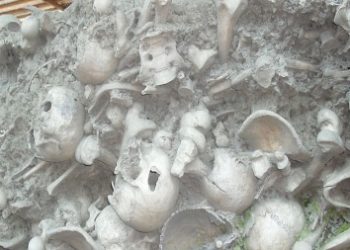

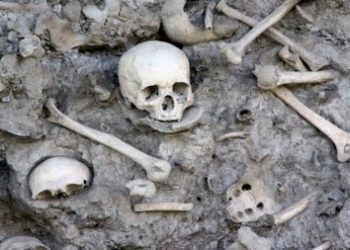 The reports of known figures of the time and media on genocide acts conducted in Azerbaijan in 1918 are on the 2nd and 3rd showcases. Articles, poems, photographs by M.A.Rasulzadeh, U. Hajibeyli, M.H. Abdulsalimzade and their copies on the events are introduced in 147th issue of “Azerbaijan” newspaper (March 31,1919). Newspapers such as “Istiglal”, “Gardash gaygisi” (“Brotherly Care”) (published in Tbilisi), “Nash Golos” (Our Voice) also covered the genocide in their own pages.
The reports of known figures of the time and media on genocide acts conducted in Azerbaijan in 1918 are on the 2nd and 3rd showcases. Articles, poems, photographs by M.A.Rasulzadeh, U. Hajibeyli, M.H. Abdulsalimzade and their copies on the events are introduced in 147th issue of “Azerbaijan” newspaper (March 31,1919). Newspapers such as “Istiglal”, “Gardash gaygisi” (“Brotherly Care”) (published in Tbilisi), “Nash Golos” (Our Voice) also covered the genocide in their own pages. 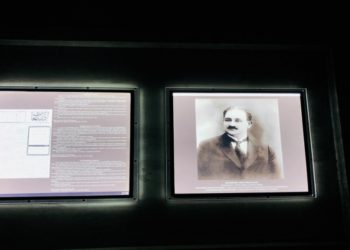
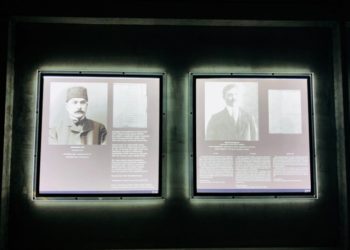 A part of the article by S.J. Javadzade (Pishavari), our compatriot from South Azerbaijan and a prominent statesman, in Ajir (Tehran) newspaper and impressions of Said Mohammad Al-Vazare Maraghayi, the consul of Iran in Azerbaijan in 1918, on the bloody acts are published on the 4th showcase. The copy of the documents written by English General L.C. Danstervil and the British vice Consul in Baku, R. McDonell in 1918 on the committed tragedies are recorded on the showcase.
A part of the article by S.J. Javadzade (Pishavari), our compatriot from South Azerbaijan and a prominent statesman, in Ajir (Tehran) newspaper and impressions of Said Mohammad Al-Vazare Maraghayi, the consul of Iran in Azerbaijan in 1918, on the bloody acts are published on the 4th showcase. The copy of the documents written by English General L.C. Danstervil and the British vice Consul in Baku, R. McDonell in 1918 on the committed tragedies are recorded on the showcase. 
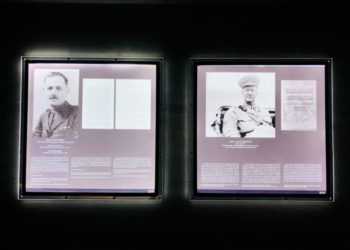
 The 5th showcase ends with an exposition dedicated to the Turkish-Azerbaijani-Caucasus Islamic Army. The government of Azerbaijan Democratic Republic undertook lots of measures to resist against massive genocide against the Muslim population by Bolshevik Armenian gangs. Bolshevik Armenian troops intended to set up Bolshevik government led by S. Shaumian who seized the мpower in Baku City and Baku provinces. The power of ADR aimed at establishing the government in the whole area of Azerbaijan and free our lands from the enemy invasion. The Caucasus Islamic Army, formed by newlycreated Azerbaijani national army and the armed forces of Ottoman Turkey, disarmed separatist Armenians in Ganja, counter attacked during the fights in Goychay province, and Garamaryam, Kurdamir and Shamakhi provinces, finally, in Baku neighbour regions and defeated the Bolshevik-Dashnak forces. The victory march of the Caucasus Islamic Army ended with the liberation of Baku City on September 15, 1918. This victory laid the foundations for the territorial integrity of Azerbaijan and resulted in the liberation of the Azerbaijani people from the Armenian Bolshevik oppression. This showcase starts with the photos of the march of Caucasus Islamic Army’s liberation of Azerbaijani lands. General, small groups and single images of Turkish and Azerbaijani officers and soldiers, as well as photos of Nuri Pasha, Commander of the Turkish Troops together with the Commander of the Azerbaijani Armed Forces, lieutenant general Aliagha Shikhlinski are on that showcase.
The 5th showcase ends with an exposition dedicated to the Turkish-Azerbaijani-Caucasus Islamic Army. The government of Azerbaijan Democratic Republic undertook lots of measures to resist against massive genocide against the Muslim population by Bolshevik Armenian gangs. Bolshevik Armenian troops intended to set up Bolshevik government led by S. Shaumian who seized the мpower in Baku City and Baku provinces. The power of ADR aimed at establishing the government in the whole area of Azerbaijan and free our lands from the enemy invasion. The Caucasus Islamic Army, formed by newlycreated Azerbaijani national army and the armed forces of Ottoman Turkey, disarmed separatist Armenians in Ganja, counter attacked during the fights in Goychay province, and Garamaryam, Kurdamir and Shamakhi provinces, finally, in Baku neighbour regions and defeated the Bolshevik-Dashnak forces. The victory march of the Caucasus Islamic Army ended with the liberation of Baku City on September 15, 1918. This victory laid the foundations for the territorial integrity of Azerbaijan and resulted in the liberation of the Azerbaijani people from the Armenian Bolshevik oppression. This showcase starts with the photos of the march of Caucasus Islamic Army’s liberation of Azerbaijani lands. General, small groups and single images of Turkish and Azerbaijani officers and soldiers, as well as photos of Nuri Pasha, Commander of the Turkish Troops together with the Commander of the Azerbaijani Armed Forces, lieutenant general Aliagha Shikhlinski are on that showcase.  The exposition is completed with a photograph reflecting the military march in Baku on September 16, 1918 on the release of Baku. The completion of the last exposition of the museum with photographs-ocuments on the National Army of Azerbaijan does not mean a historical fact of overcoming 1918 genocides with the help of the army. In fact, it once again confirms that, Azerbaijani state must have a strong army that will always protect its sovereignty, territorial integrity, and provide cosy and safe living of our people. The tragedy proved this once again. This lesson of a history is an example for future generations. IV. Three-colour flag of the Republic of Azerbaijan is raised at the “Flag Square” of Guba “Genocide Memorial Complex” at a height of 20 meters.
The exposition is completed with a photograph reflecting the military march in Baku on September 16, 1918 on the release of Baku. The completion of the last exposition of the museum with photographs-ocuments on the National Army of Azerbaijan does not mean a historical fact of overcoming 1918 genocides with the help of the army. In fact, it once again confirms that, Azerbaijani state must have a strong army that will always protect its sovereignty, territorial integrity, and provide cosy and safe living of our people. The tragedy proved this once again. This lesson of a history is an example for future generations. IV. Three-colour flag of the Republic of Azerbaijan is raised at the “Flag Square” of Guba “Genocide Memorial Complex” at a height of 20 meters. V. The visitors of the Complex feel free to use Information Center, reading hall equipped with modern supplements and computers, installed auto guides, a rich library and 16 booklets and 4 books in three languages with historical facts evidencing the genocide committed in provinces of Azerbaijan in 1918, published by Haydar Aliyev Foundation.
V. The visitors of the Complex feel free to use Information Center, reading hall equipped with modern supplements and computers, installed auto guides, a rich library and 16 booklets and 4 books in three languages with historical facts evidencing the genocide committed in provinces of Azerbaijan in 1918, published by Haydar Aliyev Foundation.










































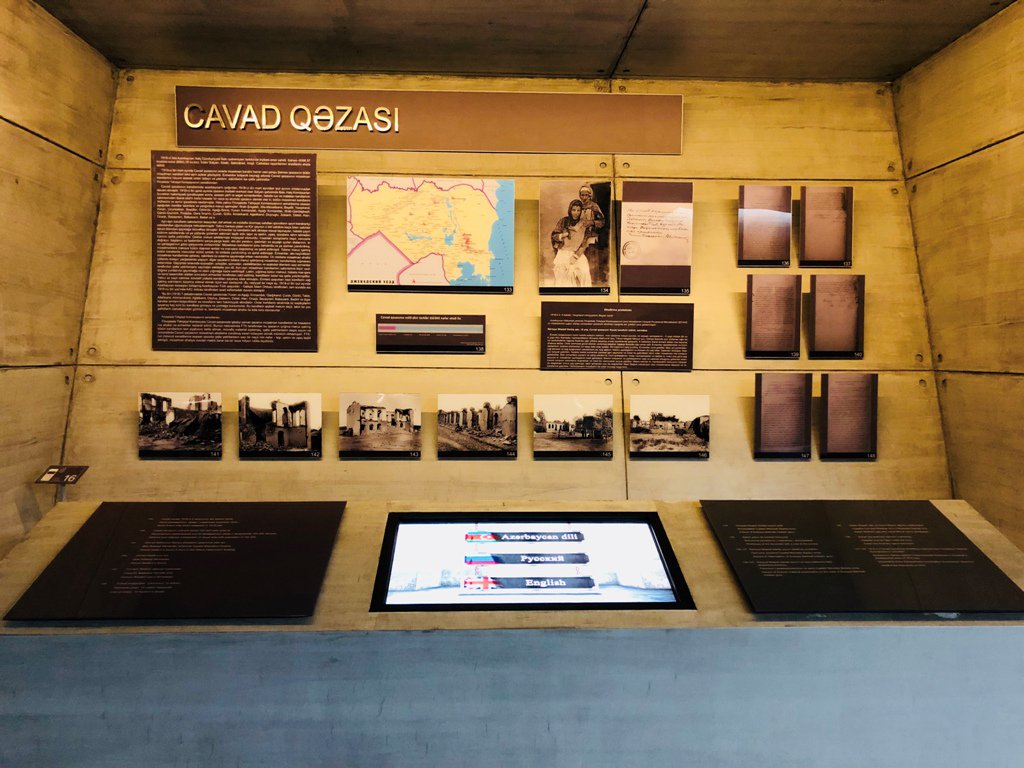

 I Memorial (a place where a mass grave found)
I Memorial (a place where a mass grave found) The mass grave was discovered on April 1, 2007, during construction works in the area. The staff of the Institute of Archaeology and Ethnography of the National Academy of Sciences of Azerbaijan carried out preliminary researches on the graveyard from 8 to 11 April, 2007 and the research has established that the burial has to do with the genocide committed by the Armenian armed groups against the local civilian population in 1918. The Scientific Council of the Institute of archeology and Ethnography of the National Academy of Sciences of Azerbaijan recommended to carry out more extensive research on the grave in order to clarify this issue. Research group of seven people of the Institute of Archeology and Ethnography of the National Academy of Sciences of Azerbaijan was engaged in research in the mass grave since July 2007, under the leadership of Gahraman Aghayev and completed in September 2008.
The mass grave was discovered on April 1, 2007, during construction works in the area. The staff of the Institute of Archaeology and Ethnography of the National Academy of Sciences of Azerbaijan carried out preliminary researches on the graveyard from 8 to 11 April, 2007 and the research has established that the burial has to do with the genocide committed by the Armenian armed groups against the local civilian population in 1918. The Scientific Council of the Institute of archeology and Ethnography of the National Academy of Sciences of Azerbaijan recommended to carry out more extensive research on the grave in order to clarify this issue. Research group of seven people of the Institute of Archeology and Ethnography of the National Academy of Sciences of Azerbaijan was engaged in research in the mass grave since July 2007, under the leadership of Gahraman Aghayev and completed in September 2008. II Symbolic Graveyard: Apple trees, symbolizing life in Guba since ancient times were planted in this part of the complex. 40 symbolic marble stones in 3 dimensions were placed in the apple garden in memory of women, young people, children and old people, who were the victims of the 1918 tragedy.
II Symbolic Graveyard: Apple trees, symbolizing life in Guba since ancient times were planted in this part of the complex. 40 symbolic marble stones in 3 dimensions were placed in the apple garden in memory of women, young people, children and old people, who were the victims of the 1918 tragedy.  III Genocide Museum consists of 3 parts: 1. Grounding of sharp-end knives (entrance) 2. Memorial stone (main hall) 3. The emergence of sharp end knives (exit) The information on the changes occured in the lives of the population in social, cultural and other fields before , during after the genocide is reported in Socio-Historical Museum, which is unique in the world and new to Azerbaijan. . Architect Vahid Kasımoghlu did not use any decor and adornment as a sign of deep respect in memory of genocide victims, the scale, burden and pain of the tragedy and tried to opitomize mournful silence. Emerging of the museum view from under the ground suggests that truth can’t be concealed, while, the sharp ends of the monument exposes the stabbing pain.
III Genocide Museum consists of 3 parts: 1. Grounding of sharp-end knives (entrance) 2. Memorial stone (main hall) 3. The emergence of sharp end knives (exit) The information on the changes occured in the lives of the population in social, cultural and other fields before , during after the genocide is reported in Socio-Historical Museum, which is unique in the world and new to Azerbaijan. . Architect Vahid Kasımoghlu did not use any decor and adornment as a sign of deep respect in memory of genocide victims, the scale, burden and pain of the tragedy and tried to opitomize mournful silence. Emerging of the museum view from under the ground suggests that truth can’t be concealed, while, the sharp ends of the monument exposes the stabbing pain.  The entrance exposition of the museum is called ” Peaceful Guba”. The images of the residents of Guba town and the town view in the 20th century were depicted in this part. The photographs of the population of Guba town – civil servants, religious figures, schoolchildren, women and other urban and rural residents were taken during the work, at home, with the family and during the rest. The representatives of other nations and ethnic groups lived in Guba region densely along with the Azerbaijani Turks. Peaceful neighborly relations between different national-ethnic and religious populations of the town were preserved for centuries. This factor shows our people’s commitment to multiculturalism tradition. The entry part ends with the epigraph of “Azerbaijan” newspaper dated 8 December, 1918.
The entrance exposition of the museum is called ” Peaceful Guba”. The images of the residents of Guba town and the town view in the 20th century were depicted in this part. The photographs of the population of Guba town – civil servants, religious figures, schoolchildren, women and other urban and rural residents were taken during the work, at home, with the family and during the rest. The representatives of other nations and ethnic groups lived in Guba region densely along with the Azerbaijani Turks. Peaceful neighborly relations between different national-ethnic and religious populations of the town were preserved for centuries. This factor shows our people’s commitment to multiculturalism tradition. The entry part ends with the epigraph of “Azerbaijan” newspaper dated 8 December, 1918.  The black marble stone were erected in the center of the hall as a sign of respect for the memory of tragedy victims, because most people, subjected to massacres during the acts of genocide in various regions of Azerbaijan were burned, thrown into the sea and wells, and therefore their burial was impossible.
The black marble stone were erected in the center of the hall as a sign of respect for the memory of tragedy victims, because most people, subjected to massacres during the acts of genocide in various regions of Azerbaijan were burned, thrown into the sea and wells, and therefore their burial was impossible.  The photos and documents of members of the Extraordinary Investigation Commission (EIC) (F.Khoyski, M.Hajinski, H.Khasmammadov, A.Khasmammadov, I. Shahmaliyev, M. Tekinski, N.Mikhaylov, A.Khanbudagov) are displayed at the entry of the hall. The government of Democratic Republic of Azerbaijan (ADR) considered it necessary to express its attitude towards the bloody the Republic exposed. The government adopted a resolution on the establishment of Extraordinary Investigation Commission on 15 July, 1918 to investigate into the cases of violence committed against Muslim population and property by Armenian armed groups under the name of Bolshevik.The chairman of the EIC was known lawyer Alakbar bey Khasmammadov. Though the commission was set up of seven members, later the representatives of the investigation and prosecutor’s office and judicial authorities of Baku and Ganja cities were implicated to this work. The composition of the EIC was multinational and mainly included Polish, Russian, German, Lithuanian Tatars and Azerbaijani lawyers studying in Russia. 36 volumes of investigative materials were collected by the EIC during the activity period of 15 July, 1918 up to 1 November, 1919. Massacres committed in Baku, Shamakhi, Guba, Goychay, Javad, Nukha and Lankaran provinces, as well as in Ganja, Garabagh and Zangazur by Armenians were investigated. As a result of EIC activities, 128 reports and draft resolutions were worked up and criminal cases were instituted on their basis against 194 people, charged of various crimes.
The photos and documents of members of the Extraordinary Investigation Commission (EIC) (F.Khoyski, M.Hajinski, H.Khasmammadov, A.Khasmammadov, I. Shahmaliyev, M. Tekinski, N.Mikhaylov, A.Khanbudagov) are displayed at the entry of the hall. The government of Democratic Republic of Azerbaijan (ADR) considered it necessary to express its attitude towards the bloody the Republic exposed. The government adopted a resolution on the establishment of Extraordinary Investigation Commission on 15 July, 1918 to investigate into the cases of violence committed against Muslim population and property by Armenian armed groups under the name of Bolshevik.The chairman of the EIC was known lawyer Alakbar bey Khasmammadov. Though the commission was set up of seven members, later the representatives of the investigation and prosecutor’s office and judicial authorities of Baku and Ganja cities were implicated to this work. The composition of the EIC was multinational and mainly included Polish, Russian, German, Lithuanian Tatars and Azerbaijani lawyers studying in Russia. 36 volumes of investigative materials were collected by the EIC during the activity period of 15 July, 1918 up to 1 November, 1919. Massacres committed in Baku, Shamakhi, Guba, Goychay, Javad, Nukha and Lankaran provinces, as well as in Ganja, Garabagh and Zangazur by Armenians were investigated. As a result of EIC activities, 128 reports and draft resolutions were worked up and criminal cases were instituted on their basis against 194 people, charged of various crimes.  1918-1920 year map of Azerbaijan, which massacred regions in 1918 marked with special red content, and boards in 4 languages (Azerbaijani, Russian,Turkish and English), containing brief information about Azerbaijani history are placed in the following exposition.
1918-1920 year map of Azerbaijan, which massacred regions in 1918 marked with special red content, and boards in 4 languages (Azerbaijani, Russian,Turkish and English), containing brief information about Azerbaijani history are placed in the following exposition.  The photo of Great Leader, Haydar Aliyev, the founder and architect of modern Azerbaijani state, the Republic of Azerbaijan, which is the successor of the ADR, considered today the duty of political assessment of the genocide acts as its historical obligation, and logical continuation, because of incomplete realization nowadays, and Decree dated March 26, 1998 on “31 March genocide of Azerbaijanis” (in 3 languages: Azerbaijani, Russian, English) were displayed at the next exposition.
The photo of Great Leader, Haydar Aliyev, the founder and architect of modern Azerbaijani state, the Republic of Azerbaijan, which is the successor of the ADR, considered today the duty of political assessment of the genocide acts as its historical obligation, and logical continuation, because of incomplete realization nowadays, and Decree dated March 26, 1998 on “31 March genocide of Azerbaijanis” (in 3 languages: Azerbaijani, Russian, English) were displayed at the next exposition.  The whole museum gallery wall comprises the expositions of 4 sections, dedicated to the town of Guba. The state of Guba as an administrative territorial unit for the year of 1918 is described in the first section. Guba town (Guba, Gusar, Shabran, Khachmaz, Siyazan) existedMuntil the time of Tsarism Russia, ADR and the year of 1929 of the Azerbaijan SSR. The genocides committed in Guba town in 1918 were specially marked on the map in red. According to the first data, 122 villages were exposed to plunders and ruins in the province, whereas, more accurate investigations defined them to be 167. 38 settlements were ruined in Guba town and surrounding villages, 27- in Gusar, 65-in Khachmaz, 21- in Shabran, and 16- in Siyazan
The whole museum gallery wall comprises the expositions of 4 sections, dedicated to the town of Guba. The state of Guba as an administrative territorial unit for the year of 1918 is described in the first section. Guba town (Guba, Gusar, Shabran, Khachmaz, Siyazan) existedMuntil the time of Tsarism Russia, ADR and the year of 1929 of the Azerbaijan SSR. The genocides committed in Guba town in 1918 were specially marked on the map in red. According to the first data, 122 villages were exposed to plunders and ruins in the province, whereas, more accurate investigations defined them to be 167. 38 settlements were ruined in Guba town and surrounding villages, 27- in Gusar, 65-in Khachmaz, 21- in Shabran, and 16- in Siyazan  Detailed information on the living of Guba town population till 1918 is provided in the second section. According to 1916 data, 64,15% out of the 198, 204 population of Guba town were Azerbaijanis (Azeris) and Tats, 24,72% -Lezghins, Griz, Budugs, Jecks, Avars, etc., 7, 58%- Jews, 2, 71% were Russians, and 0.76% were Armenians.There are photos of different nations and ethnic groups in this showcase.
Detailed information on the living of Guba town population till 1918 is provided in the second section. According to 1916 data, 64,15% out of the 198, 204 population of Guba town were Azerbaijanis (Azeris) and Tats, 24,72% -Lezghins, Griz, Budugs, Jecks, Avars, etc., 7, 58%- Jews, 2, 71% were Russians, and 0.76% were Armenians.There are photos of different nations and ethnic groups in this showcase.  A brief description of the EIC facts on the destruction, violence and genocide conducted in Guba town, as well as the documents and photographs of witnesses of the acts and interrogation protocols were demonstrated in the third section.
A brief description of the EIC facts on the destruction, violence and genocide conducted in Guba town, as well as the documents and photographs of witnesses of the acts and interrogation protocols were demonstrated in the third section.  The information on Guba town defenders exists on the fourth section. 3,000 Armenian armed gangs of Hamazasp committed brutal murders and pillages in Guba town from late April till mid-May, 1918 within two weeks by the order of Baku Soviet head, S. Shaumian. Main purpose of the Dashnak Hamazasp, who had a special hatred towards Turks, was to fulfil penal measures and to reduce the number of the Muslim population purposefully. The Armenian gangs of Hamazasp murdered without mercy, even with unprecedented cruelty, Muslim population, including children, women, old people and treated corpses ruthlessly and even banned to take them from the streets and squares, and to bury them. A document on Azerbaijani people’s being a tolerant nation even under such conditions as compared with Armenians, was presented. This document was issued for the protection of ninety Armenians’ life safety by personal signature and seal of Hamdulla Efendi Efendizade in Kilvar village of Devechi (Shabran). The photographs of defenders of Guba town were presented at the exposition (A.Zizikski, H. Efendizade, S. Efendizade, M. Ibrahimov and others). There was informed about the struggle of defense forces of Guba town against the Dashnaks-Armenians and presented the view of the area called “Bloody Valley”, located between the villages of Digah and Khujbala, where fierce battles took place.
The information on Guba town defenders exists on the fourth section. 3,000 Armenian armed gangs of Hamazasp committed brutal murders and pillages in Guba town from late April till mid-May, 1918 within two weeks by the order of Baku Soviet head, S. Shaumian. Main purpose of the Dashnak Hamazasp, who had a special hatred towards Turks, was to fulfil penal measures and to reduce the number of the Muslim population purposefully. The Armenian gangs of Hamazasp murdered without mercy, even with unprecedented cruelty, Muslim population, including children, women, old people and treated corpses ruthlessly and even banned to take them from the streets and squares, and to bury them. A document on Azerbaijani people’s being a tolerant nation even under such conditions as compared with Armenians, was presented. This document was issued for the protection of ninety Armenians’ life safety by personal signature and seal of Hamdulla Efendi Efendizade in Kilvar village of Devechi (Shabran). The photographs of defenders of Guba town were presented at the exposition (A.Zizikski, H. Efendizade, S. Efendizade, M. Ibrahimov and others). There was informed about the struggle of defense forces of Guba town against the Dashnaks-Armenians and presented the view of the area called “Bloody Valley”, located between the villages of Digah and Khujbala, where fierce battles took place.  The photographs of the delegation participated at the Paris Peace Conference of 1919 (A. Topchubashov-chairman, A. Atamalibeyov, Y. Mehdiyev, J. Hajibeyli, A.Sheikhulislamov, M, Maharramov), as well as the published historical maps of Caucasus showing borders of ADR (in French and Ottoman Turkish) were presented at the next exposition. Main purpose of the delegation was to introduce Azerbaijan as an independent state and to bring the crimes committed by the Armenians-Dashnaks against the Azerbaijani people in 1918, to the world community. For this purpose, a part of the materials of the EIC were sent to Paris through Foreign Ministry of Azerbaijan with a delegation. These materials consisted of 6 volumes of documents and 102 photos reflecting 1918 genocides committed in Baku, Shamakhi, Guba, Goychay and Javad provinces. The Azerbaijani delegation fulfilled its commitment, it was undertaken. The copies of the documents were submitted to the heads of major states and different international organizations. All the materials sent from Baku to Paris were found in personal archive of Topchubashov in France by PhD of History, Prof. Solmaz Rustamova (Tohidi) in 2011 and submitted back to the homeland after 94 years. The copies of the documents and photos are presented in their original at the museum exposition. A documentary dealt with the acts of genocide is continuously shown in the hall.
The photographs of the delegation participated at the Paris Peace Conference of 1919 (A. Topchubashov-chairman, A. Atamalibeyov, Y. Mehdiyev, J. Hajibeyli, A.Sheikhulislamov, M, Maharramov), as well as the published historical maps of Caucasus showing borders of ADR (in French and Ottoman Turkish) were presented at the next exposition. Main purpose of the delegation was to introduce Azerbaijan as an independent state and to bring the crimes committed by the Armenians-Dashnaks against the Azerbaijani people in 1918, to the world community. For this purpose, a part of the materials of the EIC were sent to Paris through Foreign Ministry of Azerbaijan with a delegation. These materials consisted of 6 volumes of documents and 102 photos reflecting 1918 genocides committed in Baku, Shamakhi, Guba, Goychay and Javad provinces. The Azerbaijani delegation fulfilled its commitment, it was undertaken. The copies of the documents were submitted to the heads of major states and different international organizations. All the materials sent from Baku to Paris were found in personal archive of Topchubashov in France by PhD of History, Prof. Solmaz Rustamova (Tohidi) in 2011 and submitted back to the homeland after 94 years. The copies of the documents and photos are presented in their original at the museum exposition. A documentary dealt with the acts of genocide is continuously shown in the hall.  Modern human faces are depicted in the applied art tableau at the next exposition. These figures embody young and old generations. Views of the faces are different. There is felt astonishment, amazement and fear on younger faces, while, there are as much as grief, sadness and bitterness on old faces.
Modern human faces are depicted in the applied art tableau at the next exposition. These figures embody young and old generations. Views of the faces are different. There is felt astonishment, amazement and fear on younger faces, while, there are as much as grief, sadness and bitterness on old faces. 
 The Armenians, who considered Azerbaijan a potential territory for the “Greater Armenia” State and at the same time aiming at minimizing the Muslim population through genocides in the region, used all means to achieve their goal. The head of the Baku Soviet, Shaumian trying to fulfill this plan, collaborated closely with the Armenian forces of the entire Caucasus, including the members of “Dashnaksytun” Party. He took harsher penal measures in different parts of Azerbaijan abusing the competences, committed to him. Thus, tragic events of 1918 were carried out by the Bolshevik-Dashnak tandem. Mass slaughters of Muslim population were committed by the troops of 70% Armenian soldiers, and led by Armenian officers since March 1918. The fact of display of the names and identities of the leaders of the Armenian forces and executors, committed genocide in Azerbaijan denies the fiction of Armenians spread in Armenians bodies of that time or even present day, about this tragedy’s being allegedly committed by the “Armenian ordinary people”.There are also shown in the showcase the sidearms, firearms and torture devices used by Armenian troops during the genocide acts.
The Armenians, who considered Azerbaijan a potential territory for the “Greater Armenia” State and at the same time aiming at minimizing the Muslim population through genocides in the region, used all means to achieve their goal. The head of the Baku Soviet, Shaumian trying to fulfill this plan, collaborated closely with the Armenian forces of the entire Caucasus, including the members of “Dashnaksytun” Party. He took harsher penal measures in different parts of Azerbaijan abusing the competences, committed to him. Thus, tragic events of 1918 were carried out by the Bolshevik-Dashnak tandem. Mass slaughters of Muslim population were committed by the troops of 70% Armenian soldiers, and led by Armenian officers since March 1918. The fact of display of the names and identities of the leaders of the Armenian forces and executors, committed genocide in Azerbaijan denies the fiction of Armenians spread in Armenians bodies of that time or even present day, about this tragedy’s being allegedly committed by the “Armenian ordinary people”.There are also shown in the showcase the sidearms, firearms and torture devices used by Armenian troops during the genocide acts.  Theme of Baku province districts follows the exposition on Javad ditrict. Javad province covers the area of present Salyan, Saatli, Imishli, Sabirabad and Jalilabad regions.The province and the composition of the population are reported in the textual part of Javad exposition. Armenians committed genocide act against Muslim population till the mid March-June, 1918 in the province. The civil population of the province was subjected to rather much persecution after Salyan’s fall under Bolsheviks’ control in April of that year. This situation continued until our lands were liberated by Azerbaijani-Turkish troops. It was impossible to obtain amount of the damage to the villages and the exact list of the killed people, since a part of the Muslim villages was still under Armenian control during the EIC activity. However, it was not difficult to imagine the scale of the atrocities and vandalism committed by Armenians against the local Muslim population. From this point of view,it would be enough to look at the questionnaire and the forensic examination protocol of the 18-year-old resident of Khojali village of Javad province, Surayya Mashadi Dadash gizi at the exposition. The assassinations were accompanied by special brutality: They run through the people with bayonets, hacked with daggers, cut their heads and burned them.
Theme of Baku province districts follows the exposition on Javad ditrict. Javad province covers the area of present Salyan, Saatli, Imishli, Sabirabad and Jalilabad regions.The province and the composition of the population are reported in the textual part of Javad exposition. Armenians committed genocide act against Muslim population till the mid March-June, 1918 in the province. The civil population of the province was subjected to rather much persecution after Salyan’s fall under Bolsheviks’ control in April of that year. This situation continued until our lands were liberated by Azerbaijani-Turkish troops. It was impossible to obtain amount of the damage to the villages and the exact list of the killed people, since a part of the Muslim villages was still under Armenian control during the EIC activity. However, it was not difficult to imagine the scale of the atrocities and vandalism committed by Armenians against the local Muslim population. From this point of view,it would be enough to look at the questionnaire and the forensic examination protocol of the 18-year-old resident of Khojali village of Javad province, Surayya Mashadi Dadash gizi at the exposition. The assassinations were accompanied by special brutality: They run through the people with bayonets, hacked with daggers, cut their heads and burned them.  Goychay province was an administrative-territorial unit within Baku province of ADR in 1918 and covered the territory of present Goychay, Kurdamir and Zardab regions. The exposition provides information on nationalreligious composition of the population (Muslim, Armenian, Russian, Jewish) in the administrative part at the exposition. The passing of several railway stations through Goychay area facilitated the attack of the Armenian armed forces left during the World War I and went back to this region. Armenians became even more aggressive with the purpose to build Bolshevik government since June, 1918. So, 84 premises were set to fire in Arab-Mehdibey Village, property was plundered and 83 people were slain. 20 residents of the Jahri village were subjected to unbearable tortures and then murdered. Their noses and ears are cut off and the skull bones are broken. The similar violence was also conducted in Kurdamir Village. EIC papers of research, implemented in the region and the photographs of burnt mosque, personal property, houses and corpses in the village are presented on the board. The liberation of our lands from Bolshevik Dashnak forces took start with conclusive fights between the BPCS army and the Caucasus Islamic Army only in the directions of Goychay settlement and Garamaryam Village on 16-30th June, 1918.
Goychay province was an administrative-territorial unit within Baku province of ADR in 1918 and covered the territory of present Goychay, Kurdamir and Zardab regions. The exposition provides information on nationalreligious composition of the population (Muslim, Armenian, Russian, Jewish) in the administrative part at the exposition. The passing of several railway stations through Goychay area facilitated the attack of the Armenian armed forces left during the World War I and went back to this region. Armenians became even more aggressive with the purpose to build Bolshevik government since June, 1918. So, 84 premises were set to fire in Arab-Mehdibey Village, property was plundered and 83 people were slain. 20 residents of the Jahri village were subjected to unbearable tortures and then murdered. Their noses and ears are cut off and the skull bones are broken. The similar violence was also conducted in Kurdamir Village. EIC papers of research, implemented in the region and the photographs of burnt mosque, personal property, houses and corpses in the village are presented on the board. The liberation of our lands from Bolshevik Dashnak forces took start with conclusive fights between the BPCS army and the Caucasus Islamic Army only in the directions of Goychay settlement and Garamaryam Village on 16-30th June, 1918.  Shamakhi province was an administrative-territorial unit and covered the areas of present Shamakhi, Agsu, Ismayilli, Gobustan,Hajigabul regions. The composition of Shamakhi province population was different for religious and national background like other provinces. Despite the majority of the province’s Muslim population, it was exposed to unexpected storming by ArmeniansBolsheviks and faced with unprecedented atrocities. The genocides in Shamakhi were launched at the same time with Baku events. Shamakhi town was hit twice in March-April, while 110 villages of the province were exposed to plunders for several times. Genocides committed by the Bolshevik-Dashnak bands in Shamakhi town lasted for several days.”Piran-Shirvan” residential estates, populated with rich Moslems were completely set on fire. The Armenians re-attacked the town on 10 April under the guidance of S. Lalayev and T. Amirov after the March massacres. Religious centers of Shamakhi, as well as Juma Mosque with 8th centuries-old history, were burnt and ruined. Generally, 106 villages of Shamakhi province were devastated by Armenians during this period and 10341 people were killed. These facts were demonstrated as photographs at the exposition.
Shamakhi province was an administrative-territorial unit and covered the areas of present Shamakhi, Agsu, Ismayilli, Gobustan,Hajigabul regions. The composition of Shamakhi province population was different for religious and national background like other provinces. Despite the majority of the province’s Muslim population, it was exposed to unexpected storming by ArmeniansBolsheviks and faced with unprecedented atrocities. The genocides in Shamakhi were launched at the same time with Baku events. Shamakhi town was hit twice in March-April, while 110 villages of the province were exposed to plunders for several times. Genocides committed by the Bolshevik-Dashnak bands in Shamakhi town lasted for several days.”Piran-Shirvan” residential estates, populated with rich Moslems were completely set on fire. The Armenians re-attacked the town on 10 April under the guidance of S. Lalayev and T. Amirov after the March massacres. Religious centers of Shamakhi, as well as Juma Mosque with 8th centuries-old history, were burnt and ruined. Generally, 106 villages of Shamakhi province were devastated by Armenians during this period and 10341 people were killed. These facts were demonstrated as photographs at the exposition.  The theme of Baku province comes to an end with Baku exposition. The factors causing these events in Baku City, where in 1918 genocide launched, and March genocide were reported there. Baku province with 442.097 population was distinctive for its multinational content. Although the population of Baku City had increased due to the migrants arrived because of the two-centuries-old transfer policy and the development of oil industry from the second half of the 19th century, the majority were Muslims, mostly Azerbaijanis. The exposition included a map of Baku province, a diagram of the nationalreligious content of the population, the photographs of victims of genocide, and interrogation protocols. The Bolshevik-Dashnak forces intensified their efforts to strike the national-liberation movement of the Azerbaijani people, to destroy the social basis of “Musavat” Party and minimize the number of Muslim population. Sabotage on disarmament of the main crew of “Evelina” streamship consisted of Azerbaijanis on March 26, 1918 was an excuse for conducting Moslem’s massacres by ten thousand Bolshevik Armenian army. Twelve thousand peaceful Moslem civils of the city were bloodshed for three days (March 30 – April 2). Existence of women, grown-ups and children among the murdered denies the claims on allegedly occurence of “civil war” inside the city and proves the massacres were committed massively against the Muslim population. All strata of Azerbaijani population were victims of violence, injustice and pillages during massacres led by slaughters of the Armenian “Dashnakstyun”, the Armenian National Council and the Bolsheviks. Quarters of Baku “Karpijkhana”, “Mammadli” and others, “Tazapir”, “Shah”, “Shamakhi”, “Haji Ajdar bey”, “Bibiheybat” mosques, as well as editorial offices of “Kaspi”, “Open Word” newspapers, the building of “Isgandariyya” and “Islamiyya” hotels were destroyed and burnt. The photos of a number of places mentioned in the exposition are provided. The genocides conducted in Baku in March-September, 1918 were also committed in Baku villages (Mahammadli, Ahmadli, Balakhani, Zarat, Sabunchu, Khirdalan, etc.) Total damage caused to Baku province amounted to about 400,000,000 rubles
The theme of Baku province comes to an end with Baku exposition. The factors causing these events in Baku City, where in 1918 genocide launched, and March genocide were reported there. Baku province with 442.097 population was distinctive for its multinational content. Although the population of Baku City had increased due to the migrants arrived because of the two-centuries-old transfer policy and the development of oil industry from the second half of the 19th century, the majority were Muslims, mostly Azerbaijanis. The exposition included a map of Baku province, a diagram of the nationalreligious content of the population, the photographs of victims of genocide, and interrogation protocols. The Bolshevik-Dashnak forces intensified their efforts to strike the national-liberation movement of the Azerbaijani people, to destroy the social basis of “Musavat” Party and minimize the number of Muslim population. Sabotage on disarmament of the main crew of “Evelina” streamship consisted of Azerbaijanis on March 26, 1918 was an excuse for conducting Moslem’s massacres by ten thousand Bolshevik Armenian army. Twelve thousand peaceful Moslem civils of the city were bloodshed for three days (March 30 – April 2). Existence of women, grown-ups and children among the murdered denies the claims on allegedly occurence of “civil war” inside the city and proves the massacres were committed massively against the Muslim population. All strata of Azerbaijani population were victims of violence, injustice and pillages during massacres led by slaughters of the Armenian “Dashnakstyun”, the Armenian National Council and the Bolsheviks. Quarters of Baku “Karpijkhana”, “Mammadli” and others, “Tazapir”, “Shah”, “Shamakhi”, “Haji Ajdar bey”, “Bibiheybat” mosques, as well as editorial offices of “Kaspi”, “Open Word” newspapers, the building of “Isgandariyya” and “Islamiyya” hotels were destroyed and burnt. The photos of a number of places mentioned in the exposition are provided. The genocides conducted in Baku in March-September, 1918 were also committed in Baku villages (Mahammadli, Ahmadli, Balakhani, Zarat, Sabunchu, Khirdalan, etc.) Total damage caused to Baku province amounted to about 400,000,000 rubles  Expositions showing the attitude of the states officials, prominent persons and media towards the genocide acts committed by Armenian troops in Azerbaijan in 1918 were demonstrated at the museum exit. The views of the graveyard discovered during 2007 constructions are on the 1st showcase (photo).
Expositions showing the attitude of the states officials, prominent persons and media towards the genocide acts committed by Armenian troops in Azerbaijan in 1918 were demonstrated at the museum exit. The views of the graveyard discovered during 2007 constructions are on the 1st showcase (photo). 


 The reports of known figures of the time and media on genocide acts conducted in Azerbaijan in 1918 are on the 2nd and 3rd showcases. Articles, poems, photographs by M.A.Rasulzadeh, U. Hajibeyli, M.H. Abdulsalimzade and their copies on the events are introduced in 147th issue of “Azerbaijan” newspaper (March 31,1919). Newspapers such as “Istiglal”, “Gardash gaygisi” (“Brotherly Care”) (published in Tbilisi), “Nash Golos” (Our Voice) also covered the genocide in their own pages.
The reports of known figures of the time and media on genocide acts conducted in Azerbaijan in 1918 are on the 2nd and 3rd showcases. Articles, poems, photographs by M.A.Rasulzadeh, U. Hajibeyli, M.H. Abdulsalimzade and their copies on the events are introduced in 147th issue of “Azerbaijan” newspaper (March 31,1919). Newspapers such as “Istiglal”, “Gardash gaygisi” (“Brotherly Care”) (published in Tbilisi), “Nash Golos” (Our Voice) also covered the genocide in their own pages. 
 A part of the article by S.J. Javadzade (Pishavari), our compatriot from South Azerbaijan and a prominent statesman, in Ajir (Tehran) newspaper and impressions of Said Mohammad Al-Vazare Maraghayi, the consul of Iran in Azerbaijan in 1918, on the bloody acts are published on the 4th showcase. The copy of the documents written by English General L.C. Danstervil and the British vice Consul in Baku, R. McDonell in 1918 on the committed tragedies are recorded on the showcase.
A part of the article by S.J. Javadzade (Pishavari), our compatriot from South Azerbaijan and a prominent statesman, in Ajir (Tehran) newspaper and impressions of Said Mohammad Al-Vazare Maraghayi, the consul of Iran in Azerbaijan in 1918, on the bloody acts are published on the 4th showcase. The copy of the documents written by English General L.C. Danstervil and the British vice Consul in Baku, R. McDonell in 1918 on the committed tragedies are recorded on the showcase. 

 The 5th showcase ends with an exposition dedicated to the Turkish-Azerbaijani-Caucasus Islamic Army. The government of Azerbaijan Democratic Republic undertook lots of measures to resist against massive genocide against the Muslim population by Bolshevik Armenian gangs. Bolshevik Armenian troops intended to set up Bolshevik government led by S. Shaumian who seized the мpower in Baku City and Baku provinces. The power of ADR aimed at establishing the government in the whole area of Azerbaijan and free our lands from the enemy invasion. The Caucasus Islamic Army, formed by newlycreated Azerbaijani national army and the armed forces of Ottoman Turkey, disarmed separatist Armenians in Ganja, counter attacked during the fights in Goychay province, and Garamaryam, Kurdamir and Shamakhi provinces, finally, in Baku neighbour regions and defeated the Bolshevik-Dashnak forces. The victory march of the Caucasus Islamic Army ended with the liberation of Baku City on September 15, 1918. This victory laid the foundations for the territorial integrity of Azerbaijan and resulted in the liberation of the Azerbaijani people from the Armenian Bolshevik oppression. This showcase starts with the photos of the march of Caucasus Islamic Army’s liberation of Azerbaijani lands. General, small groups and single images of Turkish and Azerbaijani officers and soldiers, as well as photos of Nuri Pasha, Commander of the Turkish Troops together with the Commander of the Azerbaijani Armed Forces, lieutenant general Aliagha Shikhlinski are on that showcase.
The 5th showcase ends with an exposition dedicated to the Turkish-Azerbaijani-Caucasus Islamic Army. The government of Azerbaijan Democratic Republic undertook lots of measures to resist against massive genocide against the Muslim population by Bolshevik Armenian gangs. Bolshevik Armenian troops intended to set up Bolshevik government led by S. Shaumian who seized the мpower in Baku City and Baku provinces. The power of ADR aimed at establishing the government in the whole area of Azerbaijan and free our lands from the enemy invasion. The Caucasus Islamic Army, formed by newlycreated Azerbaijani national army and the armed forces of Ottoman Turkey, disarmed separatist Armenians in Ganja, counter attacked during the fights in Goychay province, and Garamaryam, Kurdamir and Shamakhi provinces, finally, in Baku neighbour regions and defeated the Bolshevik-Dashnak forces. The victory march of the Caucasus Islamic Army ended with the liberation of Baku City on September 15, 1918. This victory laid the foundations for the territorial integrity of Azerbaijan and resulted in the liberation of the Azerbaijani people from the Armenian Bolshevik oppression. This showcase starts with the photos of the march of Caucasus Islamic Army’s liberation of Azerbaijani lands. General, small groups and single images of Turkish and Azerbaijani officers and soldiers, as well as photos of Nuri Pasha, Commander of the Turkish Troops together with the Commander of the Azerbaijani Armed Forces, lieutenant general Aliagha Shikhlinski are on that showcase.  The exposition is completed with a photograph reflecting the military march in Baku on September 16, 1918 on the release of Baku. The completion of the last exposition of the museum with photographs-ocuments on the National Army of Azerbaijan does not mean a historical fact of overcoming 1918 genocides with the help of the army. In fact, it once again confirms that, Azerbaijani state must have a strong army that will always protect its sovereignty, territorial integrity, and provide cosy and safe living of our people. The tragedy proved this once again. This lesson of a history is an example for future generations. IV. Three-colour flag of the Republic of Azerbaijan is raised at the “Flag Square” of Guba “Genocide Memorial Complex” at a height of 20 meters.
The exposition is completed with a photograph reflecting the military march in Baku on September 16, 1918 on the release of Baku. The completion of the last exposition of the museum with photographs-ocuments on the National Army of Azerbaijan does not mean a historical fact of overcoming 1918 genocides with the help of the army. In fact, it once again confirms that, Azerbaijani state must have a strong army that will always protect its sovereignty, territorial integrity, and provide cosy and safe living of our people. The tragedy proved this once again. This lesson of a history is an example for future generations. IV. Three-colour flag of the Republic of Azerbaijan is raised at the “Flag Square” of Guba “Genocide Memorial Complex” at a height of 20 meters. V. The visitors of the Complex feel free to use Information Center, reading hall equipped with modern supplements and computers, installed auto guides, a rich library and 16 booklets and 4 books in three languages with historical facts evidencing the genocide committed in provinces of Azerbaijan in 1918, published by Haydar Aliyev Foundation.
V. The visitors of the Complex feel free to use Information Center, reading hall equipped with modern supplements and computers, installed auto guides, a rich library and 16 booklets and 4 books in three languages with historical facts evidencing the genocide committed in provinces of Azerbaijan in 1918, published by Haydar Aliyev Foundation.
